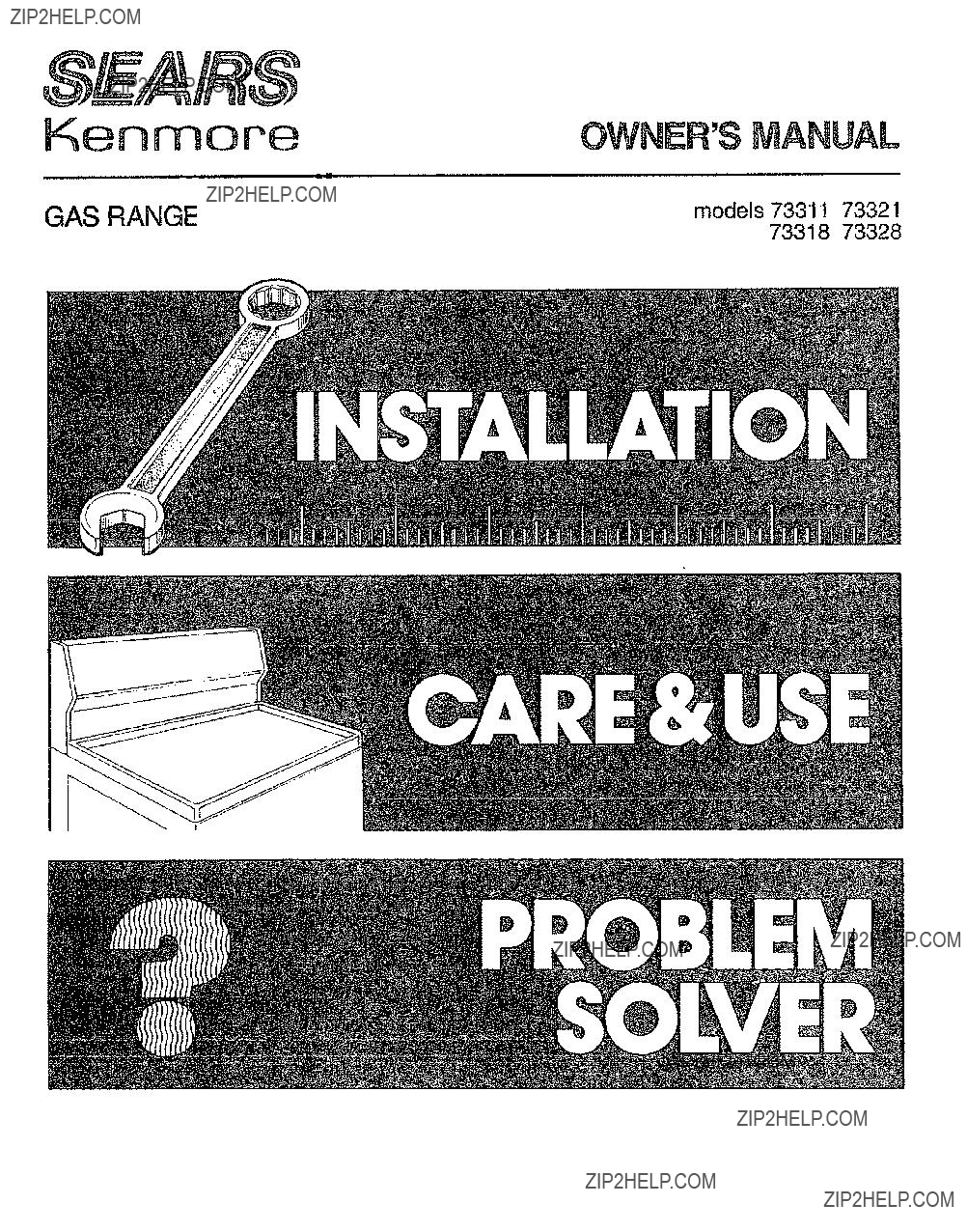
GAS RANGE
models 7331 1 73321 73318 73328

GAS RANGE
models 7331 1 73321 73318 73328

CONTENTS
iNSTALLATiON
CARE AND USE
PROBLEM SOLVER
The Problem Solver lists causes of minor operating problems that you can correct yourself.
WARRANTY

WARNaNG:If the informationin this manual is not followed exactly,a fire or explosion may resultcausingpropertydamage, personalinjuryor death.
Do not try to lightany appliance.
Do not touchany electricalswitch; do not use any phone in your building.
=immediatelycall your gas supplier from a neighbor'sphone. Follow the gas supplier'sinstructions.
if you cannot reachyour gas sup- plier,call the fire department.
performed by a qualified installer, serviceagencyor the gas supplier.
iNSTALLATiON iNSTRUCTiONS
BEFORE YOU BEGIN
Read these instructions completely and
carefully.
IMPORTANT: Save these instructions for the local electrical inspector's use.
INSTALLER: Leave these instructions with the appliance after installation is completed.
OWNER: Keep this Use and Care Guide and the Installation Instructions for future use.This
appliance must be properly grounded.
DIMENSIONS AND CLEARANCES
Provide adequate clearances between the range and adjacent combustible surfaces.
Depth with Door Closed
(Includes Door Handle): 28 Y_"_- 30
CAUTION
Remove all packing material and literature from oven before connecting gas and electri- cal supply to range.

RMPORTANT SAFETY iNSTRUCTIONS
Installation of this range must conform with local codes, or in the absence of local codes, with the
National Fuel Gas Code, ANSI Z223, latest edition.
This range has been
o Have your range installed by a qualified installer or service technician,
??? Your range must be electrically grounded in accor- dance with local codes or, in the absence of local
codes, in accordance with the National Electrical Code (ANSI/NFPA 70, latest edition). See Grounding on page 6.
?? Before installing your range on linoleum or any other synthetic floor covering, make sure the floor covering can withstand 180??F, without shrinking, warping or discoloring. Do not install the range over carpeting unless a sheet of
* Make sure the walt coverings around the range can withstand heat generated by the range up to 200??E
?? Avoid placing cabinets above the range. To reduce the hazard caused by reaching over the open flames of operating burners, install over the range a ventila- tion hood that projects forward at least 5 inches beyond the front of the cabinets.
The ventilating hood must be constructed of sheet metal not less than 040122 inch thick (No. 28 U_S,
Standard gauge), install above the cooking top with a clearance of not less than 1/4 inch between the hood
and the underside of the combustible material or metal cabinet. The hood must be at least as wide as the appliance and centered over the appliance.
Clearance between the cooking surface and the venti- lation hood surface MUST NEVER BE LESS THAN
24 INCHES.
o If cabinets are placed above the range, allow a mini- mum clearance of 30 inches between the cooking sur- face and the bottom of unprotected cabinets.
?? If a
?? Clearance between the cooking surface and protect- ed cabinets MUST NEVER BE LESS THAN 24
INCHES. The vertical distance from the plane of the cooking surface to the bottom of adjacent overhead cabinets extending closer than 1 inch to the plane of the range sides must not be less than t8 inches?? (See diagram on page 2)
o Caution: Items of interest to children should not be stored in cabinets above a range or on the backsplash of a
WARNING
All ranges can tip and injury could result. To prevent accidental tipping of the range, attach an approved
device to the wall. (See page 10.) To check if the device is installed and
engaged properly, carefully tip the range forward,. The
If you pull the range out from the walt for any reason, make sure the AntFTip device is engaged when you push the range back against the wall,
??? For your safety, never use your range for warming or heating the room?? Your oven and cooktop are not designed to heat your kitchen. Top burners should not be operated without cookware on the grates Such abuse could result in fire and damage to your range and will void your warranty.
??? Do not store or use combustible materials, gasoline or other flammable vapors and liquids in the vicinity of
this or any other appliance.. Explosions or fires could result.
???Do not use oven for a storage area. Items stored in the oven can ignite.
???Do not let cooking grease or other flammable materi- als accumulate in or near the range.
(continued next page)
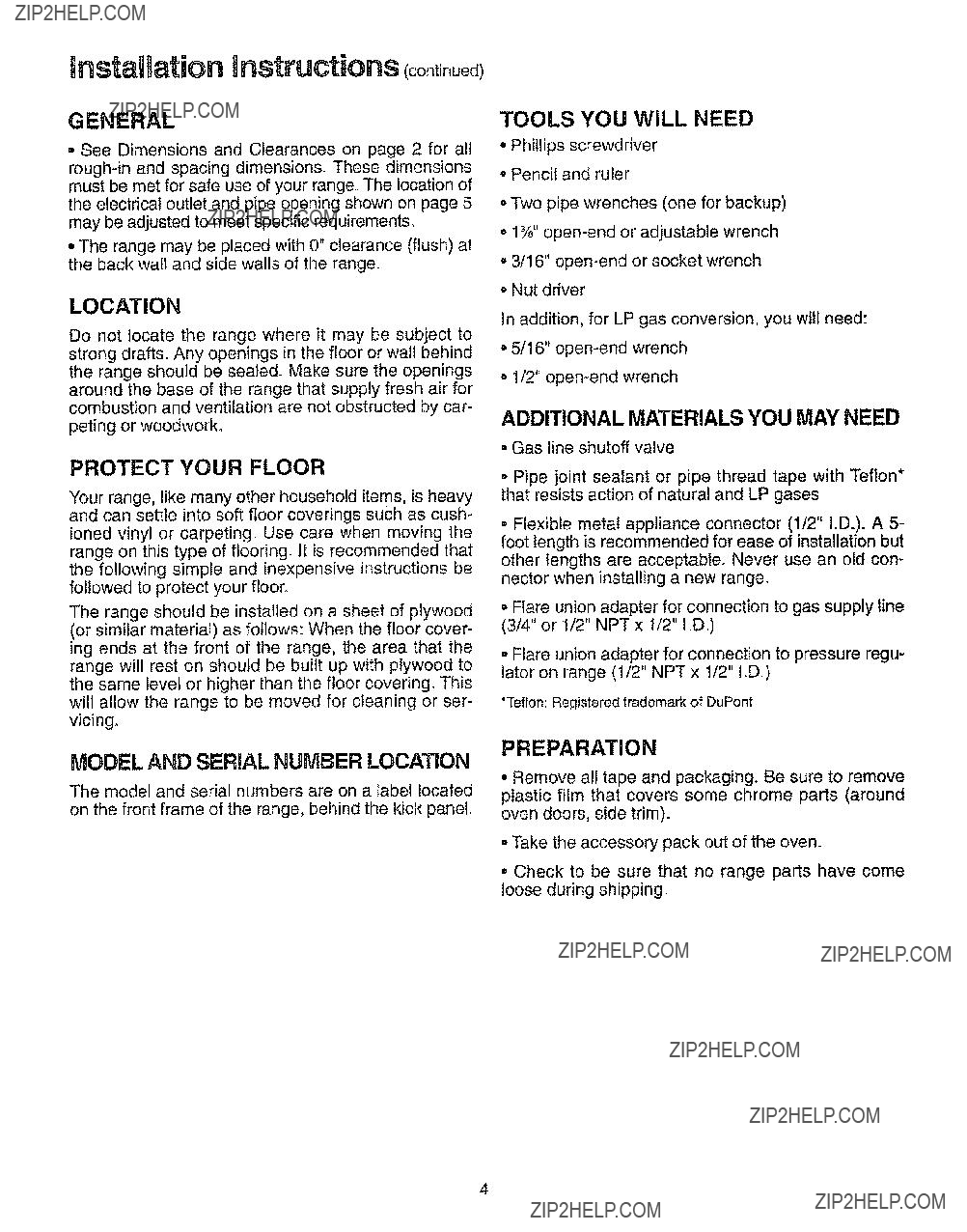
installation Instructions (continued)
GENERAL
= See Dimensions and Clearances on page 2 for all
??? The range may be placed with 0" clearance (flush) at the back wall and side walls of the range.
TOOLS YOU WILL NEED
??? Phillips screwdriver ?? Pencil and ruler
o Two pipe wrenches (one for backup)
??
??3/16"
??? Nut driver
LOCATION
Do not locate the range where it may be subject to strong drafts. Any openings in the floor or wall behind the range should be sealed. Make sure the openings around the base of the range that supply fresh air for combustion and ventilation are not obstructed by car- peting or woodwork.
In addition, for LP gas conversion, you will need: ?? 5/16"
??? 1/2" opemend wrench
ADDITIONAL MATERIALS YOU MAY NEED
?? Gas line shutoff valve
PROTECT YOUR FLOOR
Your range, like many other household items, is heavy and can settle into soft floor coverings such as cush- ioned vinyl or carpeting?? Use care when moving the range on this type of flooring. It is recommended that the following simple and inexpensive instructions be followed to protect your floor.
The range should be installed on a sheet of plywood (or similar material) as follows: When the floor cover- ing ends at the front of the range, the area that the range will rest on should be built up with plywood to the same level or higher than the floor covering. This will allow the range to be moved for cleaning or ser- vicing.
??Pipe joint sealant or pipe thread tape with Teflon* that resists action of natural and LP gases
??Flexible metal appliance connector (1/2" I.D.). A 5- foot length is recommended for ease of installation but
other lengths are acceptable. Never use an old con- nector when installing a new range.
??? Flare union adapter for connection to gas supply line (3/4" or t/2" NPT x 1/2" I.D)
o Flare union adapter for connection to pressure regu- later on range (112" NPT x 1/2" ID.)
"Teflon: Registered trademark of DuPont
MODEL AND SEROALNUMBER LOCATION
The model and serial numbers are on a label located
on the front frame of the range, behind the kick panel
PREPARATION
??? Remove all tape and packaging. Be sure to remove plastic film that covers some chrome parts (around oven doors, side trim).
o Take the accessory pack out of the oven.
?? Check to be sure that no range parts have come loose during shipping..

NORMAL iNSTALLATiON STEPS
Step t
Provide Adequate Gas Supply
The range is designed to operate at a pressure of 4 inches of water column on natural gas or, if designed for LP gas (propane or butane), 10 inches of water column. Make sure the range is supplied with the type of gas for which it is designed. If, at any time in the future, the range is to be supplied with a different type of gas, conversion adjustments must be made by a qualified service technician before attempting to oper- ate the range on that gas.
For proper operation, the pressure of natural gas sup- plied to the regulator must be between 4 and 13 inch- es of water column. For LP gas, the pressure supplied must be between 10 and 13 inches of water column.
When checking for proper operation of the regulator, the inlet pressure must be at least 1 inch greater than the operating (manifold) pressure as given above. The pressure regulator located at the inlet of the range manifold must remain in the supply line regardless of whether natural or LP gas is being used. A flexible metal appliance connector used to connect the range to the gas supply line should have an I D. of 1/2" and be 5 feet in length (shorter and longer lengths are acceptable) for ease of installation.
Gas Pipe and Electric Outlet Locations:
Recommended area for 120V outlet on rear wail and area for thru the waft connection of
pipe stub and
Recommended area for thru the floor connection
of pipe stub and
ValVe
Flexible Connector Hookup Rigid Pipe Hookup
Step 2
Connect the Range to Gas
Before disconnecting the old range, shut off the main gas supply valve and leave it off until new
Because hard piping restricts movement of the range, the use of an A.G.A._certified flexible metal appliance connector is recommended unless local codes require a
To prevent gas leaks, wrap pipe thread tape with "Teflon* around, or put pipe joint compound on, all mate (external) pipe threads.
*Teflon: Registered trademark of DuPont
1. Install a manual gas line
2.Install male 1/2" flare union adapter to the I/2" NPT internal thread at inlet of pressure regulator.
3.Install male 1/2" or 3/4" flare union adapter to the NPT internal thread of the manual
ing care to back up the
4. Connect flexible metal appliance connector to the
adapter on the range, Position range to permit con- nection at the
(continued next page,)

installation Unstructions (coothued)
5. When all connections have been made, make sure all range controls are in the off position and turn on the main gas supply valve Use a liquid leak detector at all joints and connections to check for leaks in the system,
CAUTION: DO NOT USE A FLAME TO CHECK
FOR GAS LEAKS.
When using test pressures greater than 1/2 psig to
Step 3
Electrical Connections
Electrical Requirements:
Extension Cord Cautions:
Because of potential safety hazards associated with certain conditions, we strongly recommend against the use of an extension cord. However, if you still elect to use an extension cord, it is absolutely necessary that it be a
FOR PERSONAL SAFETY, THIS APPLIANCE MUST
BE PROPERLY GROUNDED..
The power cord of this appliance is equipped with a
The customer should have the wall receptacle and cir- cuit checked by a qualified electrician to make sure the receptacle is properly grounded
Where a standard
DO NOT, UNDER ANY CIRCUMSTANCES, CUT OR
REMOVE THE THIRD (GROUND) PRONG FROM
THE POWER CORD.
Usage Situations Where Appliance Power Cord
Will Be Disconnected INFREQUENTLY:
An adapter may be used only on a
Adapter plugs not permitted in Canada
Align large prongs!slots
CAUTION: Attaching the adapter ground terminal to the wall receptacle cover screw does not ground the appliance unless the cover screw is metal and not insulated, and the wall receptacle is grounded through the house wiring. The customer should have the circuit checked by a qualified electrician to make sure the receptacle is properly grounded..
When disconnecting the power cord from the adapter, always hold the adapter with one hand If this is not done, the adapter ground terminal is very likely to break with repeated use. Should this happen, DO NOT USE the appliance until a proper ground has again been established

Usage Situations Where Appliance Power Cord
Will Be Disconnected FREQUENTLY:
Do not use an adapter plug in these situations because disconnecting of the power cord places undue strain on the adapter and leads to eventual fail- ure of the adapter ground terminal The customer should have the
The installation of appliances designed for mobile home installation must conform with the Manufactured
Home Construction and Safety Standard, Title 24 CFR, Part 3280 (formerly the Federal Standard for Mobile Home Construction and Safety, Title 24, HUD, Part 280) or, when such standard is not applicable, the Standard for Manufactured Home Installations, lat- est edition (Manufactured Home Sites, Communities and
Electrical Disconnect
1. Locate disconnect
plug at left rear of burner box on the
range back.
2. Pinch sides of con-
nector and pull out of range back.
Step 4
Seal the Openings
Seal any openings in the wall behind the range and in the floor under the range when hookups are completed.
Step 5
Check Ignition of Surface Burners
Operation of all cooktop and oven burners should be checked after range and gas supply lines have been carefully checked for leaks..
Select a top burner knob and simultaneously push in and turn to LITE position. You will hear a snapping sound indicating proper operation of the spark mod- ule. Once the air has been purged from the supply lines, burners should light within 4 seconds. After
burner lights, rotate knob out of the LITE position. Try each burner in succession until all burners have been checked..
Quality of Flames:
The combustion quality of burner flames needs to be determined visually.
(A) Yellow
(B) Yellow tips on outer
Normal for LP gas
(C) Soft blue
Normal for natural gas
??? If burner flames look like (A), call for service. Normal burner flames should look like (B) or (C), depending on the type of gas you use.
?? With LP gas, some yellow tipping on outer cones is normal.
Check ngnition of Oven Burner
Your oven is designed to operate quietly and automati- cally. To operate the oven, turn the OVEN SET knob to BAKE and OVEN TEMP knob to 350??R After
seconds, the oven burner will ignite and burn until the set temperature is reached. The oven burner will con- tinue to cycle on and off as necessary to maintain the
oven at the temperature indicated by the OVEN TEMP knob.
The oven requires electrical power to operate. The oven cannot be lit during a power outage. Gas will not flow unless the glow bar is hot.
If the oven is in use when a power outage occurs, the oven burner will shut off and cannot be
power is restored..
(continued next page)
7

installation instructions (coot ued)
Step 6
Broil and Oven Burner
Air Adjustment Shutters
Air adjustment shutters for the top and bottom burners regulate the flow of air to the flames??
The air adjustment shutter for the top burner is in the center of the rear wall of the oven,
The shutter for the bottom burner is near the back wall
behind the kick panel,. Remove the kick panel by lifting up the bottom of the panel and pulling it toward you
until the spring clips at the top of the panel are released.
To adjust the flow of air to either burner, loosen the Phillips head screw and rotate the shutter to allow more or less air into the burner tube as needed.
The flames for the top (broil) burner should burn steady with approximately 1" blue cones and should not extend out over the edges of the burner baffle.
With the baffle removed, properly adjusted flames should have approximately 1" blue cones and, if range is supplied with natural gas, should burn with no yellow tipping_ (With most LP gas, small yellow tips at the end of outer cones are normaL) With the baffle in place, the flames should burn steady and should not extend past the edges of the burner baffle. Flames should not lift off burner ports. If lifting is observed, gradually reduce air shutter opening until flames are stabilized??
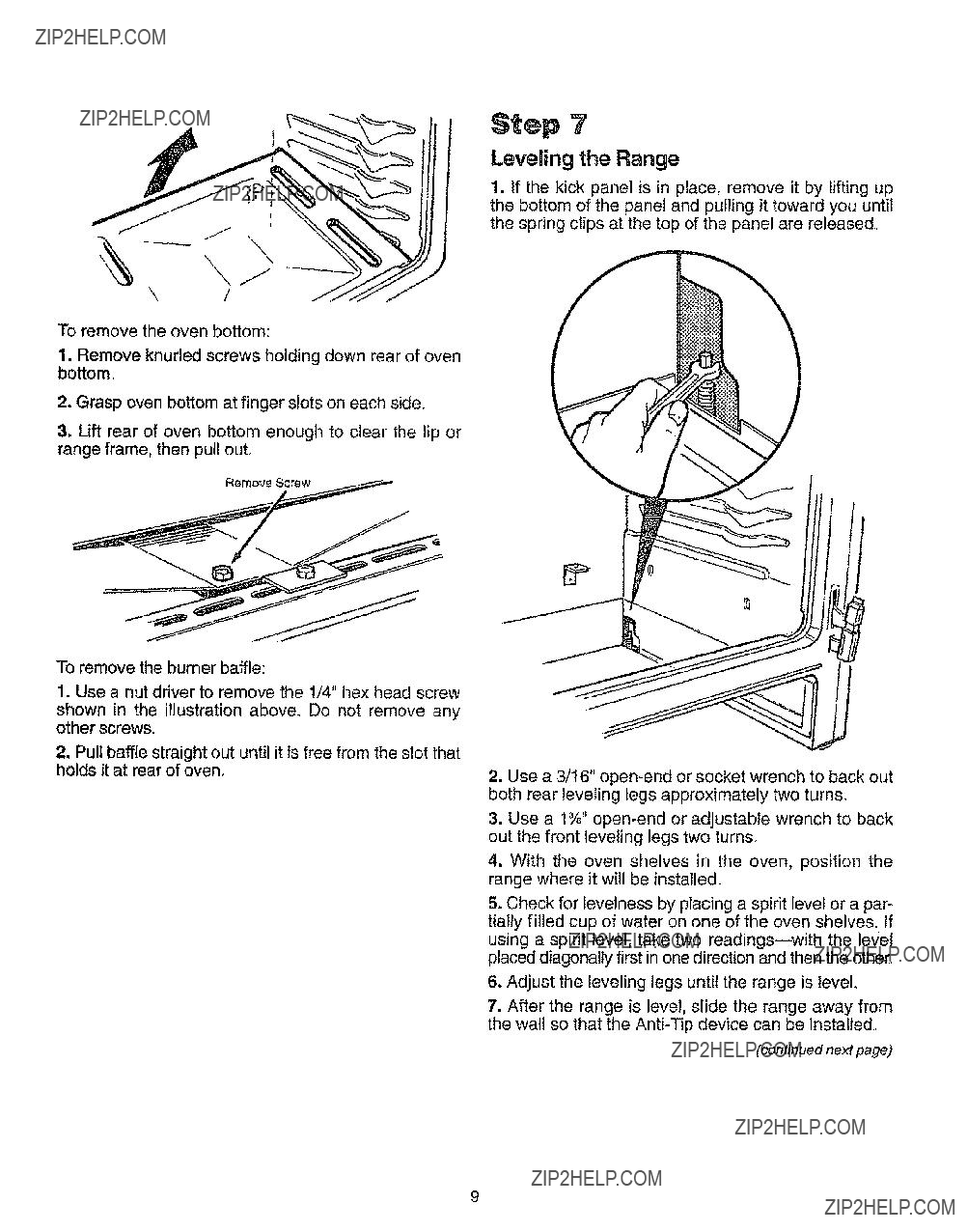
Toremovethe ovenbottom:
1.Removeknurledscrewsholdingdownrearof oven bottom.
2.Graspovenbottomat fingerslotson eachside,
3.Lift rear of oven bottomenoughto clearthe lip or rangeframe,thenpullout??
Remove Screw
To remove the burner baffle:
1. Use a nut driver to remove the 1/4" hex head screw
shown in the illustration above?? Do not remove any other screws.
2. Pull baffle straight out until it is free from the slot that holds it at rear of oven.
Step ?
Leveling the Range
1. If the kick panel is in place, remove it by lifting up the bottom of the panel and pulling it toward you until the spring clips at the top of the panel are released.
2.Use a 3/16"
3.Use a t??"
4.With the oven shelves in the oven, position the range where it will be installed.
5.Check for levelness by placing a spirit level or a par_ tially filled cup of water on one of the oven shelves. If using a spirit level, take two
placed diagonally first in one direction and then the other,
6.Adjust the leveling legs until the range is level.
7.After the range is level, slide the range away from the wall so that the
(continued next page)
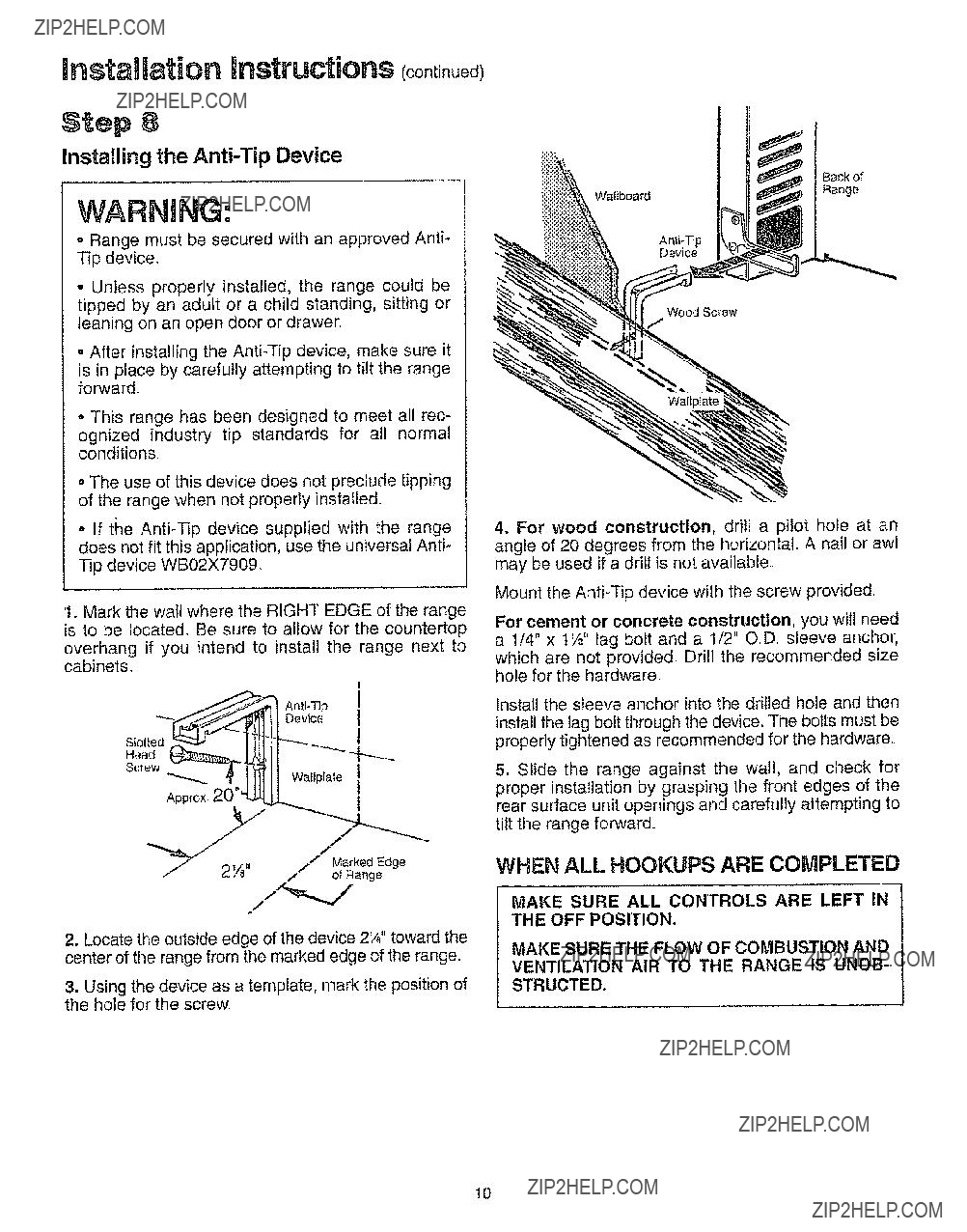
mnstaHUationinstructions (continued)
Step 8
installing the
WARNING:
o Range must be secured with an approved Anti- Tip device??
o Unless properly installed, the range could be tipped by an adult or a child standing, sitting or leaning on an open door or drawer.
. After installing the
is in place by carefully attempting to tilt the range forward??
o This range has been designed to meet al! rec-
ognized industry tip standards for all normal conditions.
??The use of this device does not preclude tipping of the range when not properly instatled_
??If the
Tip device WB02X7909
1. Mark the wall where the RIGHT EDGE of the range is to be located?? Be sure to allow for the countertop overhang if you intend to install the range next to cabinets.
!
Device
Wood Screw
4. For wood construction, drill a pilot hole at an angle of 20 degrees from the horizontal. A nail or awl may be used if a drill is not available,
Mount the
For cement or concrete construction, you will need a 1/4" x 11A''lag bolt and a 1/2" ODo sleeve anchor, which are not provided, Drill the recommended size hole for the hardware.
2. Locate the outside edge of the dewce 2?? toward the center of the range from the marked edge of the range..
3. Using the device as a template, mark the position of the hole for the screw.
Install the sleeve anchor into the drilled hole and then install the tag bolt through the device, The bolts must be properly tightened as recommended for the hardware.,
5. Slide the range against the wall, and check for proper installation by grasping the front edges of the rear surface unit openings and carefully attempting to tilt the range forward..
WHEN ALL HOOKUPS ARE COMPLETED
MAKE SURE ALL CONTROLS ARE LEFT IN
THE OFF POSITION.
MAKE SURE THE FLOW OF COMBUSTION AND
VENTILATION AIR TO THE RANGE IS UNOB-
STRUCTED.
10

HOW TO CONVERT THE RANGE FOR USE WiTH LP GAS
WARNING: Do not remove the pressure regulator from the range. l
Step t
Convert The Pressure Regulator
For LP Gas
1. Remove the cooktop and locate the pressure regu- lator at right rear of the range1
2. Determine which figure, A, B, or C, is appropriate for your regulator type.
If it is regulator A:
1. Use a coin to remove the cap from the pressure regulator.
2, Turn the cap over and engage it in the slots, LP should now be visible on the top of the cap..
If it is regulator B:
1. Unscrew the
2.Carefully pry the protective plastic cap off the threaded metal cap,, Gently pull the plastic washer off the other threads.
3.Replace the plastic cap onto the threaded end dis- playing the gas type you desire. Press the plastic
washer onto the remaining threads.
4. Reinsert the cap assembly into the regulator., Do not overtighten, but ensure the seating of the washer.,
If it is regulator C:
1. Remove cap and forcibly snap out plastic plunger from bottom of cap.
2. Turn plunger over and forcibly snap back in original location. Note: Plunger must snap into position; the gas type you are converting to must be visible on lower side of plunger.
3. Reinsert the assembly into the regulator.
Step 2
Convert Surface Burners For LP Gas
I. Lift cooktop,
NATDb oR
},%?? T " oo.o',o_.o.o,'p,o'oo". oop".
RangInto _
Do not remove this
ROTATE OPEN
C
2.Lift burner assemblies straight up and set aside to gain access to surface burner spuds,
3.With a 5/16" wrench, remove each of the four brass spuds on the surface burner gas inlet tubes and replace them with the
mounted in a holder at the right rear of the range, above the regulator. (Mount the brass natural gas spuds in this holder.,) To prevent leakage, make sure spuds are securely screwed into gas inlet tubes.,
4.Replace the burner assemblies,
5.Keep the natural gas spuds with your range so yoHt have them if you move or get a natural gas
(continued next page)
11
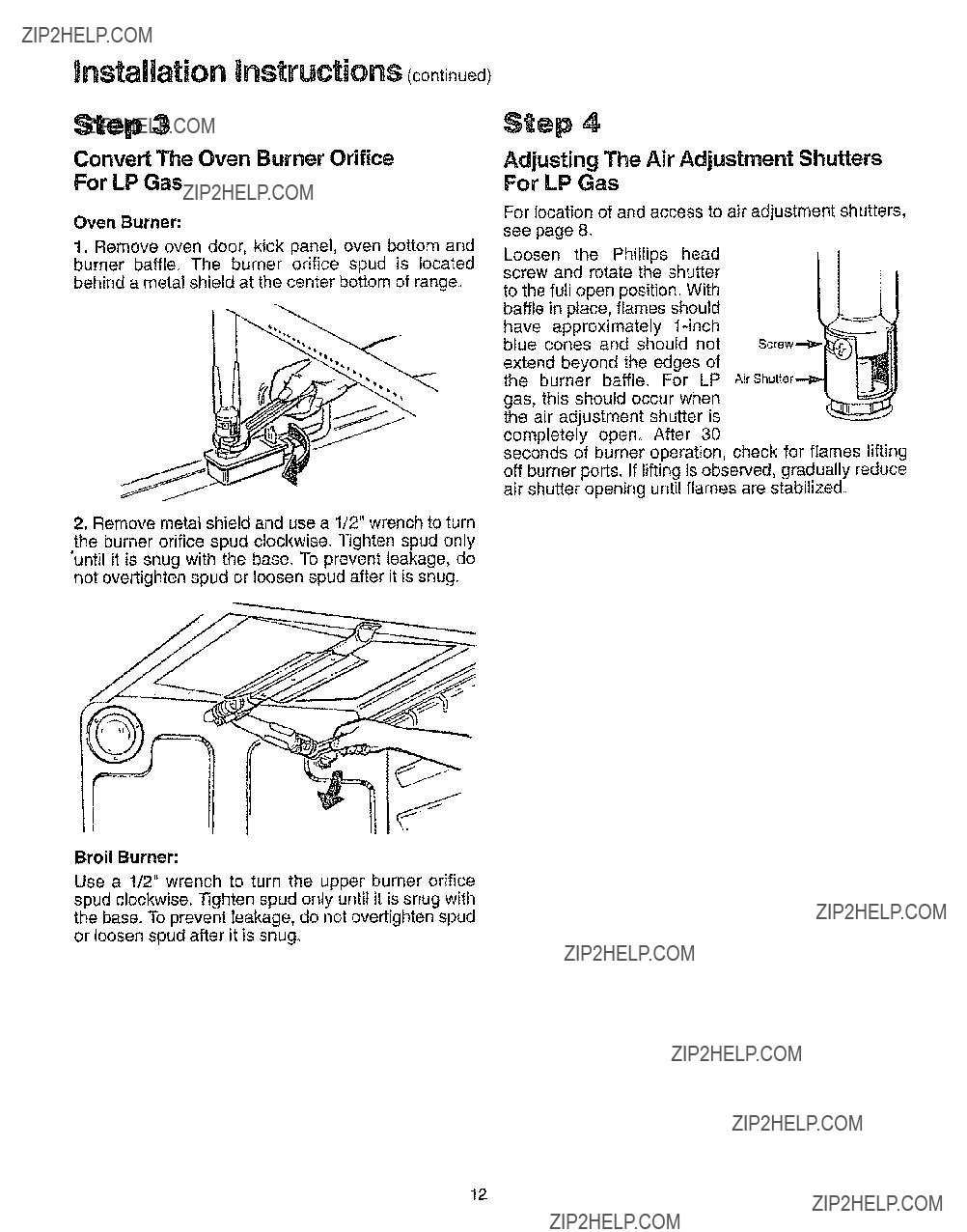
Installation Instructions (continued)
Step :3
Convert The Oven Burner Orifice
For LP Gas
Oven Burner:
1. Remove oven door, kick panel, oven bottom and burner baffle, The burner orifice spud is located behind a metal shield at the center bottom of range??
2. Remove metal shield and use a 1/2" wrench to turn the burner orifice spud clockwise?? Tighten spud only "until it is snug with the base. To prevent leakage, do not overtighten spud or loosen spud after it is snug.
Step 4
Adjusting The Air Adjustment Shutters
For LP Gas
For location of and access to air adjustment shutters,
seconds of burner operation, check for flames lifting off burner ports. If lifting is observed, gradually reduce air shutter opening until flames are stabilized.
Broil Burner:
Use a 1/2" wrench to turn the upper burner orifice spud clockwise. Tighten spud only until it is snug with the base. To prevent leakage, do not overtighten spud or loosen spud after it is snug.
I2
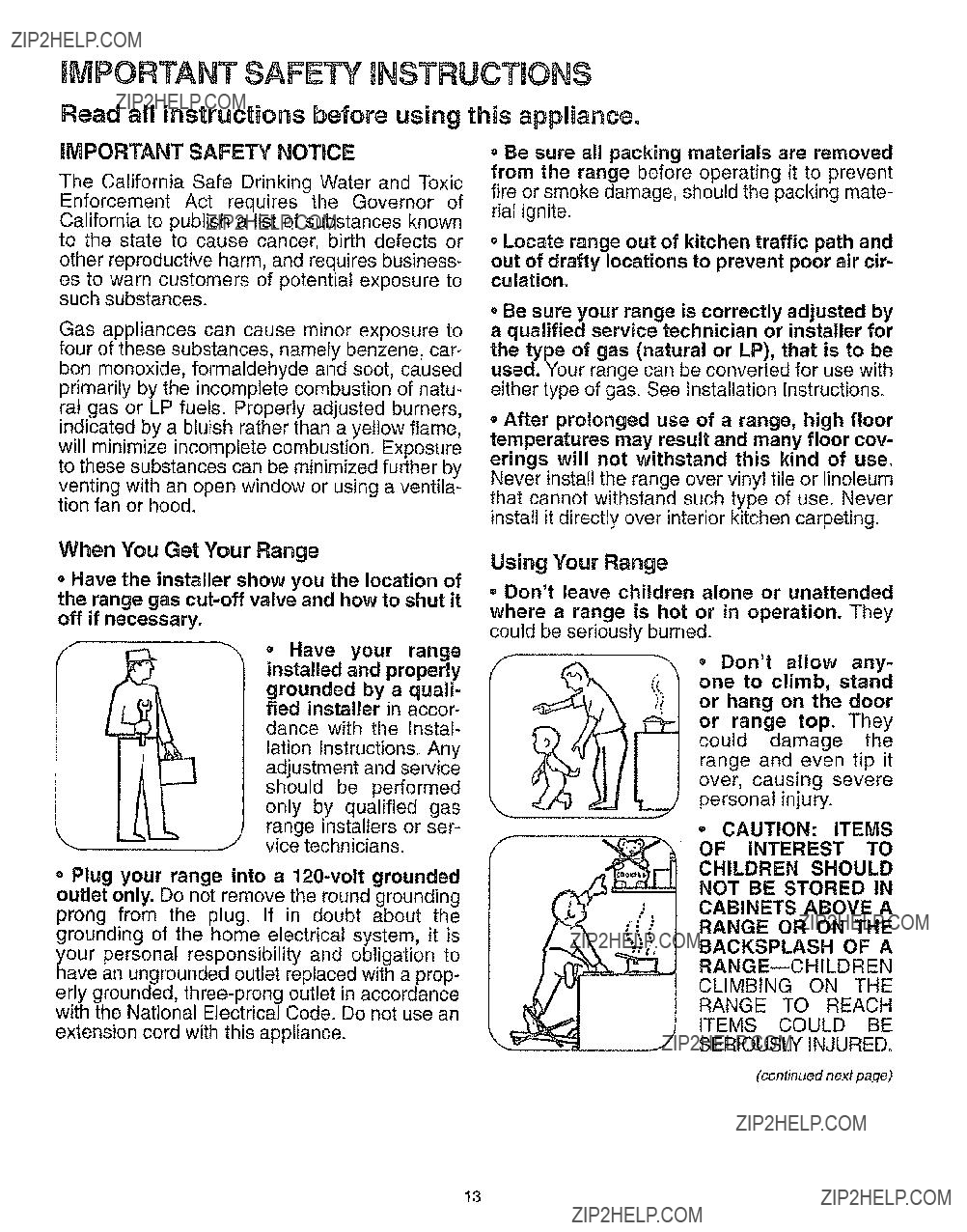
iMPORTANT SAFETY mNSTRUCTBONS
Read all instructions before using this appliance.
IMPORTANT SAFETY NOTICE
The California Safe Drinking Water and Toxic Enforcement Act requires the Governor of California to publish a list of substances known to the state to cause cancer, birth defects or other reproductive harm, and requires business-
es to warn customers of potential exposure to such substances.
Gas appliances can cause minor exposure to four of these substances, namely benzene, car- bon monoxide, formaldehyde and soot, caused primarily by the incomplete combustion of natu- ral gas or LP fuels. Properly adjusted burners, indicated by a bluish rather than a yellow flame, will minimize incomplete combustion. Exposure to these substances can be minimized further by venting with an open window or using a ventila- tion fan or hood.
When You Get Your Range
o Have the installer show you the location of the range gas
o Have your range installed and properly
grounded by a quali- fied installer in accor- dance with the Instal-
lation Instructions?? Any adjustment and service should be performed only by qualified gas
range installers or ser- vice technicians.
??? Plug your range into a
, Be sure all packing materials are removed from the range before operating it to prevent fire or smoke damage, should the packing mate- rial ignite.
o Locate range out of kitchen traffic path and
out of drafty locations to prevent poor air cir- culation.
o Be sure your range is correctly adjusted by a qualified service technician or installer for the type of gas (natural or LP), that is to be used. Your range can be converted for use with either type of gas?? See Installation Instructions.
?? After prolonged use of a range, high fleer temperatures may result and many floor cov- erings will not withstand this kind of use, Never install the range over vinyl tile or linoleum that cannot withstand such type of use. Never install it directly over interior kitchen carpeting.
Using Your Range
o Don't leave children alone or unattended where a range is hot or in operation. They could be seriously burned.
(continued next page)
I3
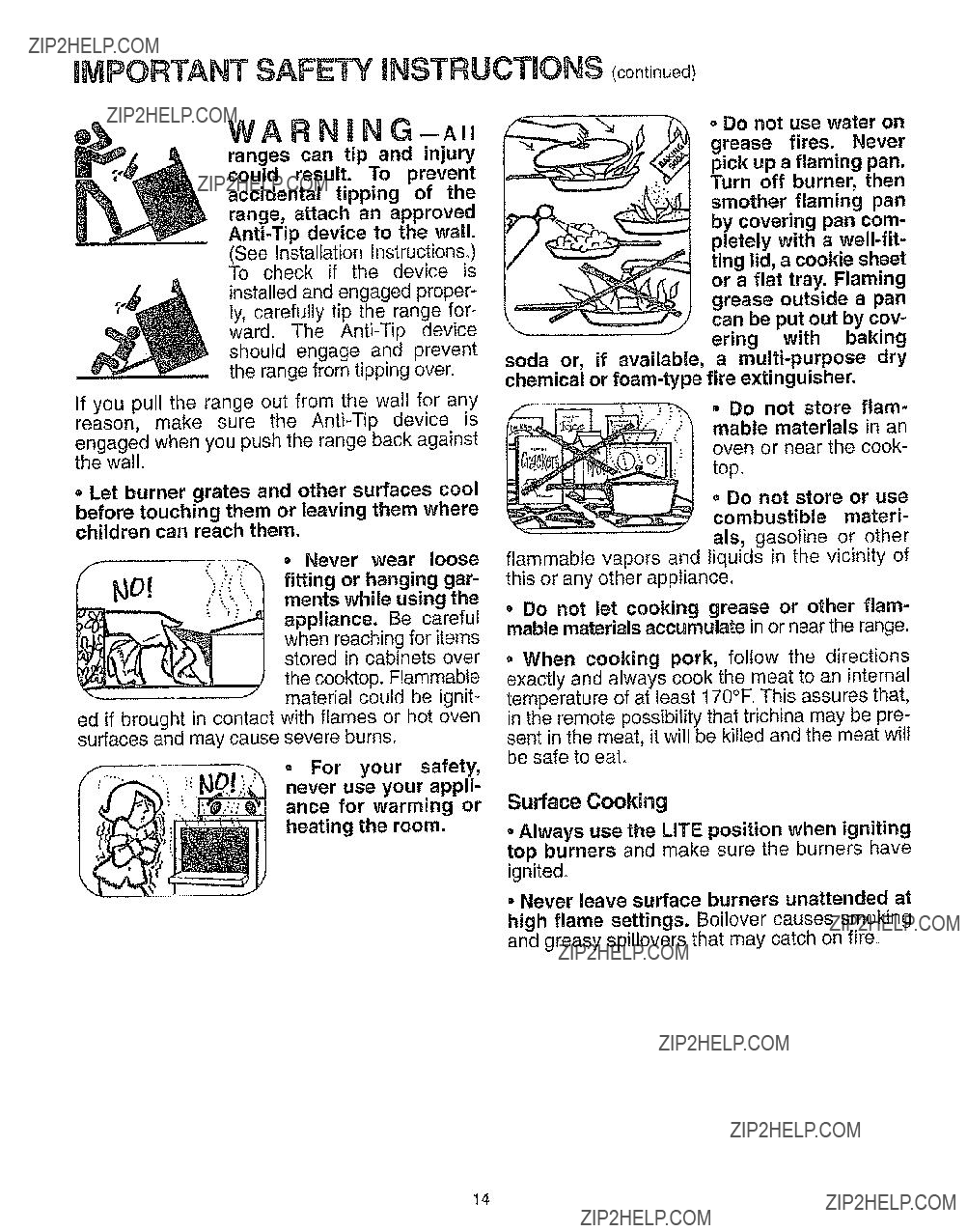
?? Let burner grates and other surfaces cool before touching them or leaving them where children can reach them.
= Never wear loose fitting or hanging gar- ments while using the appliance. Be careful
when reaching for items stored in cabinets over
the cooktop. Flammable
material could be ignit- ed if brought in contact with flames or hot oven surfaces and may cause severe burns.
??? For your safety, never use your appli- ance for warming or heating the room.
= Do not store or use combustible materi-
als, gasoline or other flammable vapors and liquids in the vicinity of this or any other appliance,
o Do not let cooking grease or other flam- mable materials accumulate in or near the range.
o When cooking pork, follow the directions exactly and always cook the meat to an internal temperature of at least 170??E This assures that, in the remote possibility that trichina may be pre- sent in the meat, it will be killed and the meat will be safe to eat.
Surface Cooking
=Always use the LITE position when igniting top burners and make sure the burners have ignite&
??? Never leave surface burners unattended at
high flame settings. Boilover causes smoking and greasy spillovers that may catch on fire
14

= Adjust top burner flame size so it does not extend beyond the edge of the cookware.
Excessive flame is hazardous_
. Use only dry pot
Do not let pot holders come near open flames when lifting cookware. Do not use a towel or other bulky cloth in place of a pot holder.
??? To minimize the possibility of burns, ignition
of flammable materials and spillage, turn cook- ware handles toward the side or back of the
range without letting them extend over adjacent burners.
??? Always turn surface burner to OFF before removing cookware.
?? Carefully watch foods being fried at a high flame setting.
??? Never block the vents (air openings) of the range. They provide the air inlet and outlet that are necessary for the range to operate properly with correct combustion. Air openings are locat- ed in the following places:
??? Do not use a wok on the cooking surface if the wok has a round metal ring that is placed over the burner grate to support the wok. This ring acts as a heat trap, which may damage the burner grate and burner head. Also, it may cause the burner to work improperly. This may cause a carbon monoxide level above that
allowed by current standards, resulting in a health hazard.
??? Foods for frying should be as dry as possi- ble. Frost on frozen foods or moisture on fresh
foods can cause hot fat to bubble up and over sides of pan.
?? Use least possible amount of fat for effec-
tive shallow or
, if a combination of oils or fats will be used
in frying, stir together before heating or as fats melt slowly.
o Always heat fat slowly and watch as it heats.
??? Use
?? Use proper pan size. Avoid pans that are unstable or easily tipped?? Select cookware with flat bottoms large enough to cover burner grates. To avoid spillovers, make sure cookware is large enough to contain food properly. This will both save cleaning time and prevent hazardous accumulations of food, since heavy spattering or spillovers left on the range can ignite. Use pans with handles that can be easily grasped and will remain cool.
o When using glass cookware, make sure it is designed for
o Keep all plastics away from top burners.
o Do not leave plastic items on the cook-
toputhey may melt if left too close to the vent.
??Do not leave any items on the cooktop. The hot air from the vent may ignite flammable items and will increase pressure in closed containers, which may cause them to burst.
??To avoid the possibility of a burn, always be certain that the controls for all burners are at
the OFF position and all grates are cool before attempting to remove a grate.
??? When flaming foods are under the hood, turn the fan off. The fan, if operating, may spread the flames.
. If range is located near a window, do not use
long curtains that could blow over the top burn- ers and create a fire hazard.
??? If you smell gas, turn off the gas to the range and call a qualified service technician. Never use an open flame to locate a leak.
(continued next page)
15

IMPORTANT SAFE NSTRUCTUONS (oont o.e
Baking, BroUing and Roasting
??? Do not use oven for a storage area. Items stored in the oven can ignite.
Stand away from the range when opening the door of a hot oven. The hot air and steam
that escape can cause burns to hands, face and eyes.
o Keep oven free from grease buildup.
??? Place oven shelves in desired position while oven is cool.
o Pulling out shelf to the
precaution against burns from touching hot surfaces of the door or oven walls.
??? Don'theat unopened food containers in the oven, Pressure could build up and the con- tainer could burst, causing an injury,
??? Don't use aluminum foil anywhere in the oven except as described in this book. Misuse could result in a fire hazard or damage to the range??
Do not clean door gasket. The door gasket is essential for a good seal. Care should be taken not to rub, damage or move the gasket,
o Do not use oven cleaners. No commercial oven cleaner or oven liner protective coating of any kind should be used in or around any part of the oven.
???Before
???Clean only parts listed in this Use and Care
Book.
???Keep range clean and free of accumulations of grease or spillovers, which may ignite.
If You Need Service
o Read "The Problem Solver" on page 34 of this book.
Don't attempt to repair or replace any part of your range unless it is specifically recom- mended in this book. All other servicing should be referred to a qualified technician
???When using cooking or roasting bags in the oven, follow the manufacturer's directions.
???Use only glass cookware that is recom- mended for use in gas ovens,
o Always remove broiler pan from oven as soon as you finish broiling. Grease left in the pan can catch on fire if oven is used without removing the grease from the broiler pan.
o When broiling, if meat is too close to the flame, the fat may ignite, Trim excess fat to prevent excessive
= Make sure broiler pan is in place correctly to reduce the possibility of grease fires.
??? If you should have a grease fire in the broil-
er pan, turn off the oven and keep door closed to contain fire until it burns out.
SAVE THESE mNSTRUCTRONS
16

Features of Your Range
o I
\
1 Surface Burners, Grates and Drip Pans (on models so equipped)
2 Oven Cleaning Indicator Light
3 OVEN SET Knob
4 Oven "On" Indicator Light
5 Automatic Oven Timer, Clock
and Minute Timer
6 OVEN TEMP Knob
7 Oven Vents
8
18, 28, 30
26, 27
20
20
19
20
21,28
28
17
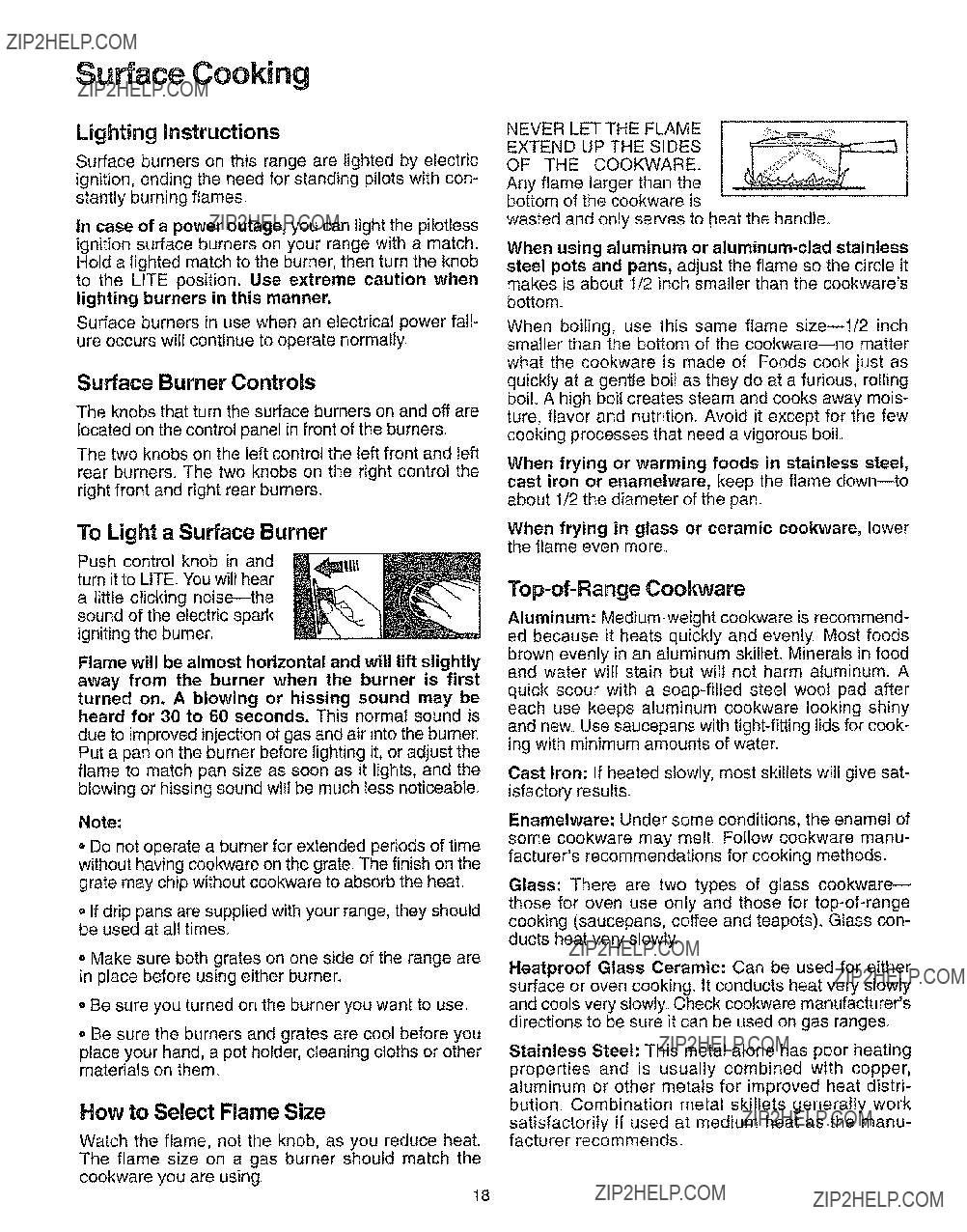
Surface Cooking
Lighting Instructions
Surface burners on this range are lighted by electric ignition, ending the need for standing pilots with con- stantly burning flames,
tn case of a power outage, you can light the pilotless ignition surface burners on your range with a match. Hold a lighted match to the burner, then turn the knob to the LITE position, Use extreme caution when lighting burners in this manner.
Surface burners in use when an electrical power fail- ure occurs will continue to operate normally.
Surface Burner Controls
The knobs that turn the surface burners on and off are located on the control panel in front of the burners.
The two knobs on the left control the left front and left rear burners. The two knobs on the right control the right front and right rear burners.
To Light a Surface Burner
Push control knob in and turn it to LITE You wilt hear a little clicking
Flame will be almost horizontal and will lift slightly
away from the burner when the burner is first
turned on. A blowing or hissing sound may be heard for 30 to 60 seconds. This normal sound is
due to improved injection of gas and air into the burner. Put a pan on the burner before lighting it, or adjust the flame to match pan size as soon as it lights, and the blowing or hissing sound will be much less noticeable.
Note:
= Do not operate a burner for extended periods of time without having ceokware on the grate. The finish on the grate may chip without cookware to absorb the heat.
o If drip pans are supplied with your range, they should be used at all times.
o Make sure both grates on one side of the range are in place before using either burner,.
?? Be sure you turned on the burner you want to use,
. Be sure the burners and grates are cool before you place your hand, a pot holder, cleaning cloths or other materials on them.
How to Select Flame Size
Watch the flame, not the knob, as you reduce heat. The flame size on a gas burner should match the cookware you are using..
NEVER LET THE FLAME
EXTEND UP THE SIDES
OF THE COOKWARE.
Any flame larger than the . bottom of the cookware is
wasted and only serves to heat the handler
When using aluminum or
steel pots and pans, adjust the flame so the circle it makes is about 1/2 inch smaller than the cookware's
bottom.
When boiling, use this same flame
what the cookware is made of. Foods cook just as quickly at a gentle boil as they do at a furious, rolling belle A high boil creates steam and cooks away mois- ture, flavor and nutrition. Avoid it except for the few cooking processes that need a vigorous boil.
When frying or warming foods in stainless steel, cast iron or enamelware, keep the flame
When frying in glass or ceramic cookware, lower the flame even more.
Aluminum:
Cast Iron: If heated slowly, most skillets will give sat- isfactory results.
Enamelware: Under some conditions, the enamel of some cookware may melt, Follow cookware manu- facturer's recommendations for cooking methods.
Glass: There are two types of glass
Heatproof Glass Ceramic: Can be used for either surface or oven cooking, tt conducts heat very slowly and cools very slowly. Check cookware manufacturer's directions to be sure it can be used on gas ranges.
Stainless Steel: This metal alone has poor heating properties and is usually combined with copper, aluminum or other metals for improved heat distri- bution.. Combination metal skillets generally work
satisfactorily if used at medium heat as the manu- facturer recommends.
18
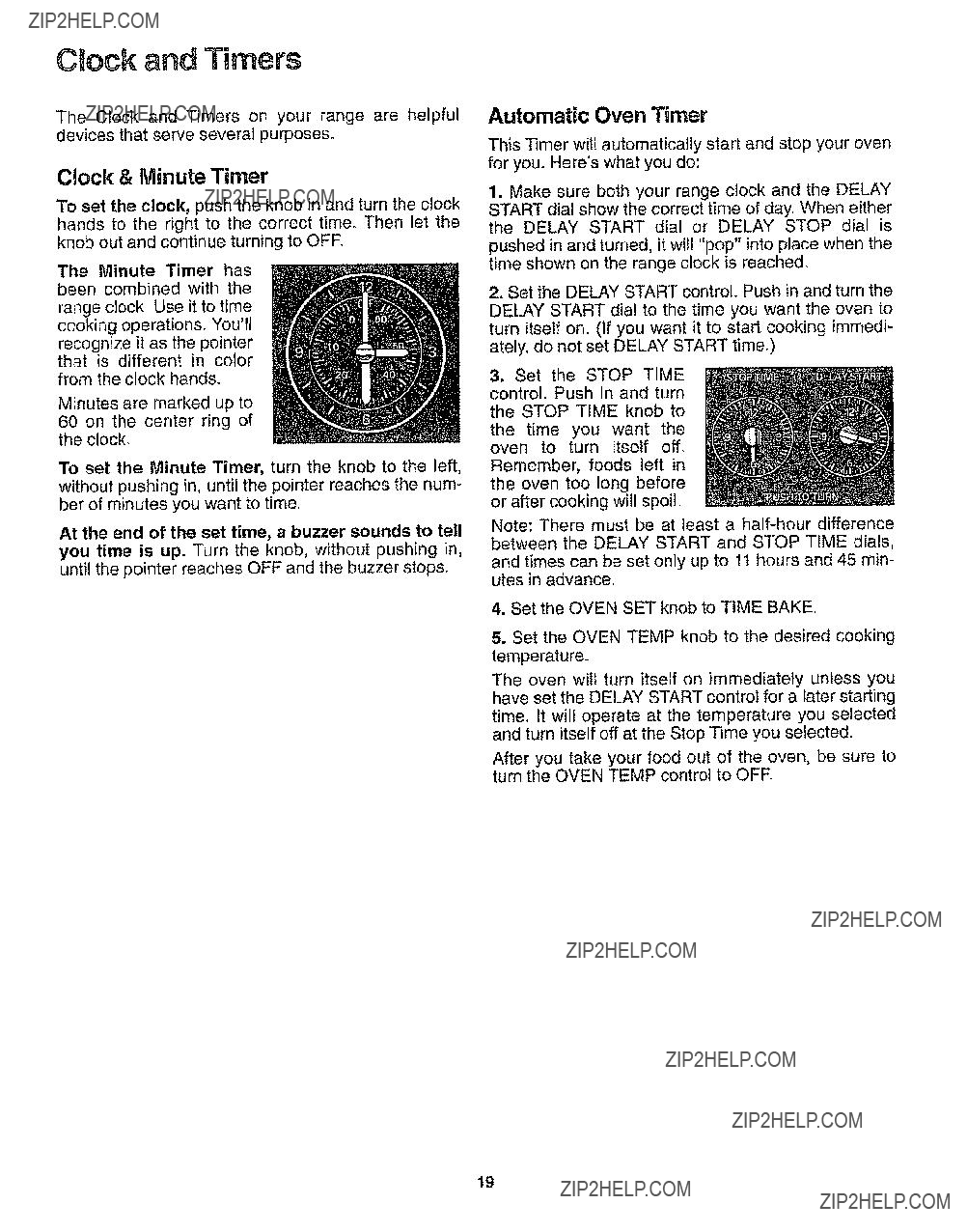
Ctock and Timers
The Clock and Timers on your range are helpful devices that serve several purposes??
Clock & Minute Timer
To set the clock, push the knob in and turn the clock hands to the right to the correct time. Then let the knob out and continue turning to OFE
The Minute Timer has been combined with the
range clock. Use it to time cooking operations. You'll
recognize it as the pointer that is different in color
from the clock hand&
Minutes are marked up to 60 on the center ring of the clock.
To set the Minute Timer, turn the knob to the left, without pushing in, until the pointer reaches the num- ber of minutes you want to time..
At the end of the set time, a buzzer sounds to tell
you time is up. Turn the knob, without pushing in, until the pointer reaches OFF and the buzzer stops.
Automatic Oven Timer
This Timer will automatically start and stop your oven for you. Here's what you do:
1. Make sure both your range clock and the DELAY START dial show the correct time of day. When either the DELAY START dial or DELAY STOP dial is pushed in and turned, it will "pop" into place when the time shown on the range clock is reached.
2. Set the DELAY START control. Push in and turn the DELAY START dial to the time you want the oven to turn itself on. (If you want it to start cooking immedi- ately, do not set DELAY START time.)
3. Set the STOP TIME control. Push in and turn the STOP TIME knob to
the time you want the oven to turn itself off.
Remember, foods left in the oven too long before or after cooking will spoil..
Note: There must be at least a
and times can be set only up to 1t hours and 45 min- utes in advance.
4.Set the OVEN SET knob to TIME BAKE.
5.Set the OVEN TEMP knob to the desired cooking temperature..
The oven will turn itself on immediately unless you have set the DELAY START controi for a later starting time. it will operate at the temperature you selected and turn itself off at the Stop Time you selected??
After you take your food out of the oven, be sure to turn the OVEN TEMP controt to OFF
19

Using Your Oven
Electric Ignition
The oven burner and broil burner on your range are lit by electric ignition..
To light either burner, turn the OVEN SET knob to the desired oven operation and the OVEN TEMP knob to the desired temperature. The burner should ignite within 60 seconds.
Before Using Your Oven
Be sure you understand how to set the controls prop- erly, Practice removing and replacing the shelves while the oven is cool Read the information and tips on the following pages. Keep this book handy where
you can refer to
Power Outage
CAUTION: DO NOT MAKE ANY ATTEMPT TO
OPERATE THE ELECTRIC IGNITION OVEN
DURING AN ELECTRICAL POWER OUTAGE.. Neither the oven nor the broiler can be lit during an electrical power outage. Gas will not flow unless the glow bar is hot.,
If the oven is in use when a power outage occurs, the oven burner shuts off and cannot be
power is restored..
Oven Controls
The controls for your oven are marked OVEN SET and OVEN TEMP.
The OVEN SET control
has settings for BAKE, BROIL, TIME BAKE and CLEAN When you turn the knob to the desired setting, the proper burner is acti- vated for that operation.
TIME
??? The OVEN TEMP control maintains the tempera- ture you set for normal oven operation as well as for broiling. Push in and turn clockwise to set tempera- tures or to set into CLEAN position
not operate.. The OVEN TEMP knob should be turned to OFF whenever the oven is not in use
For normal oven operation, push in and turn the knob clockwise to the desired temperature which is marked in 25 ?? increments. It will normally take 30 to 60 seconds before the flame comes ono
After the oven reaches the selected temperature, the oven burner
Oven indicator Light
The oven indicator light glows until the oven reaches your selected temperature, then goes off and on with the oven burner(s) during cooking.
Oven Interior Light
When the door is opened, the oven light comes on automatically. A manual on/off switch is located to the left of the surface burner controls??
2O
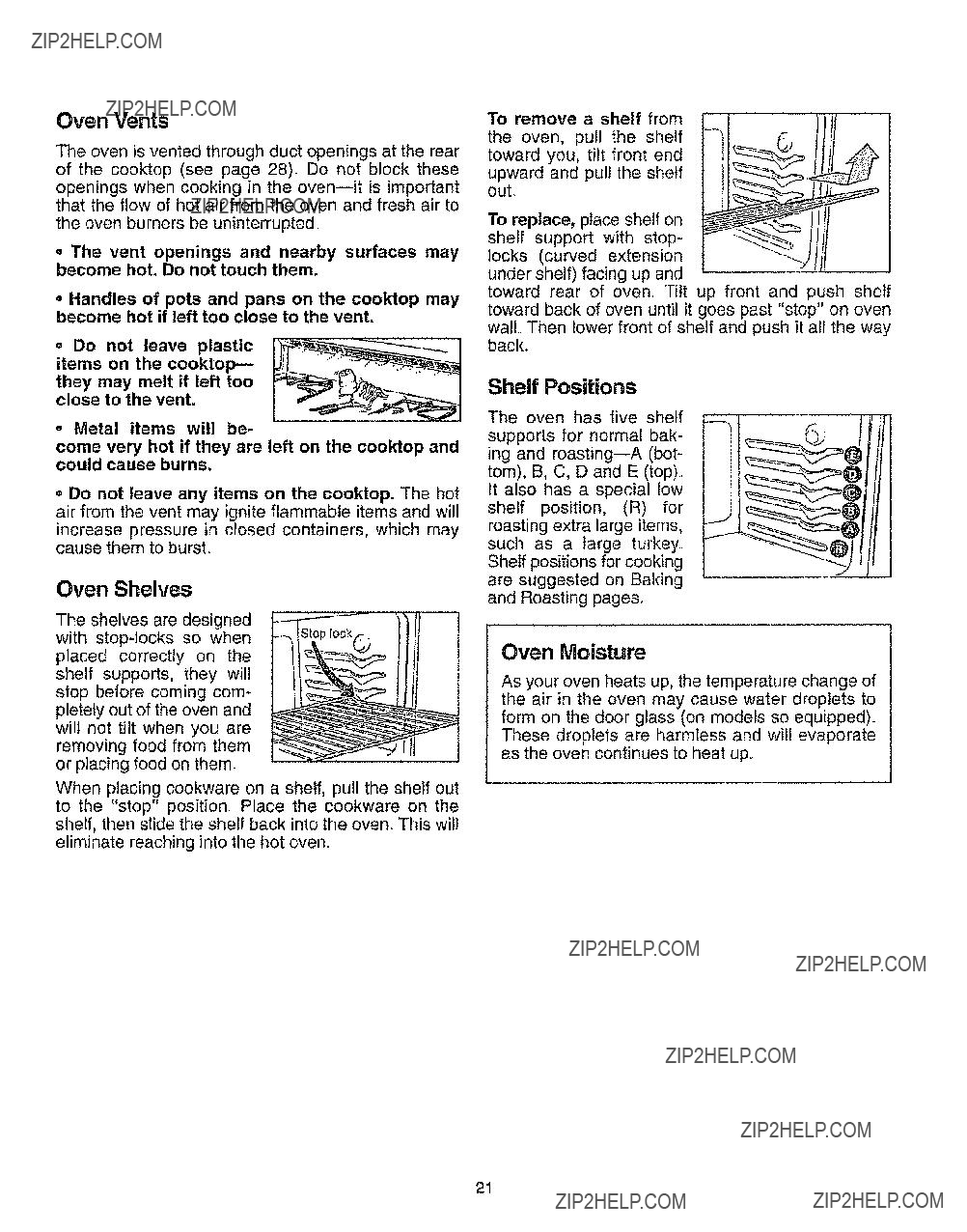
Oven Vents
The oven is vented through duct openings at the rear of the cooktop (see page 28). Do not block these openings when cooking in the
= The vent openings and nearby surfaces may become hot. Do not touch them.
??? Handles of pots and pans on the cooktop may become hot if left too close to the vent.
?? Do not leave plastic items on the
they may melt if left too close to the vent.
o Metal items will be-
come very hot if they are left on the cooktop and could cause burns.
??? Do not leave any items on the cooktop. The hot air from the vent may ignite flammable items and will
increase pressure in closed containers, which may cause them to burst.
Oven Shelves
The shelves are designed with
When placing cookware on a shelf, pull the shelf out to the "stop" position?? Place the cookware on the shelf, then slide the shelf back into the oven.. This wilt eliminate reaching into the hot oven.
To remove a shelf from the oven, pull the shelf toward you, tilt front end upward and pull the shelf out??
To replace, place shelf on shelf support with stop- locks (curved extension under shelf) facing up and
toward rear of oven.. Tilt up front and push shelf toward back of oven until it goes past "stop" on oven wall. Then lower front of shelf and push it all the way back.
Shelf Positions
The oven has five shelf supports for normal bak- ing and
shelf position, (R) for . 1II roasting extra large items,
such as a large turkey. Shelf positions for cooking are suggested on Baking and Roasting pages.
Oven Moisture
As your oven heats up, the temperature change of the air in the oven may cause water droplets to form on the door glass (on models so equipped).
These droplets are harmless and will evaporate as the oven continues to heat up..
21
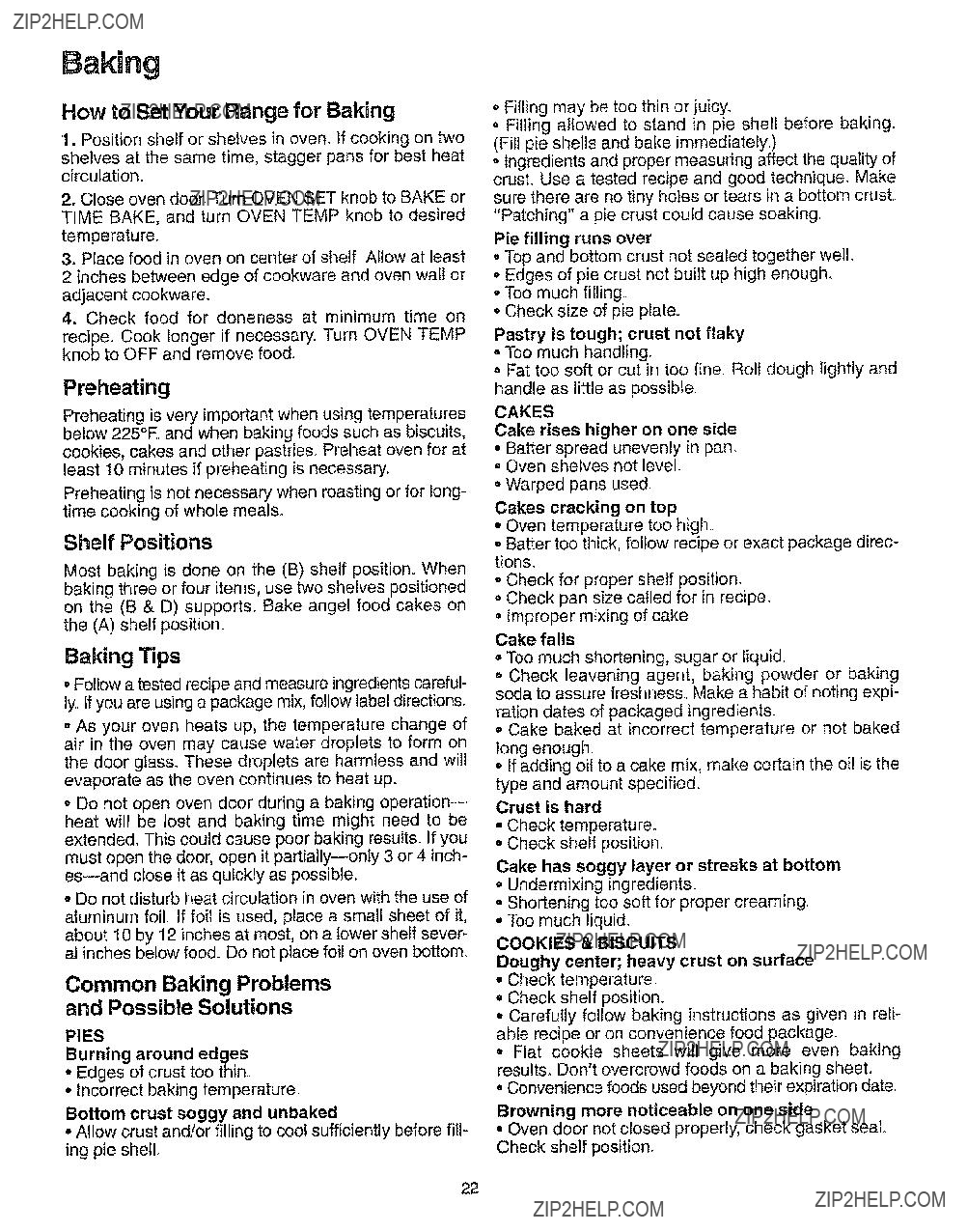
Baking
How to Set Your Range for Baking
1. Position shelf or shelves in oven, tf cooking on two shelves at the same time, stagger pans for best heat circulation.
2. Close oven door?? Turn OVEN SET knob to BAKE or
TIME BAKE, and turn OVEN TEMP knob to desired temperature,,
3. Place food in oven on center of shelf, Allow at least 2 inches between edge of cookware and oven walt or adjacent cookware??
4. Check food for doneness at minimum time on
recipe, Cook longer if necessary. Turn OVEN TEMP knob to OFF and remove food.
Preheating
Preheating is very important when using temperatures below 225??R and when baking foods such as biscuits, cookies, cakes and other pastries. Preheat oven for at least 10 minutes if preheating is necessary_
Preheating is not necessary when roasting or for long- time cooking of whole meals
Shelf Positions
Most baking is done on the (B) shelf position,, When baking three or four items, use two shelves positioned on the (B & D) supports. Bake angel food cakes on the (A) shelf position.
Baking Tips
???Follow a tested recipe and measure ingredients careful- ly, If you are using a package mix, follow label directions.,
???As your oven heats up, the temperature change of air in the oven may cause water droplets to form on
the door glass. These droplets are harmless and will evaporate as the oven continues to heat up.
?? Do not open oven door during a baking
??? Do not disturb heat circulation in oven with the use of aluminum foil. If foil is used, place a small sheet of it, about 10 by 12 inches at most, on a lower shelf sever- al inches below food. Do not place foil on oven bottom.
Common Baking Problems
and Possible Solutions
PIES
Burning around edges
??Edges of crust too thin_
??Incorrect baking temperature??
Bottom crust soggy and unbaked
?? Allow crust and/or filling to cool sufficiently before fill- ing pie shell.
??? Filling may be too thin or juicy.
??Filling allowed to stand in pie shell before baking, (Fill pie shells and bake immediately.,)
??Ingredients and proper measuring affect the quality of
crust. Use a tested recipe and good technique. Make sure there are no tiny holes or tears in a bottom crust_ "Patching" a pie crust could cause soaking,
Pie filling runs over
?? Top and bottom crust not sealed together wello = Edges of pie crust not built up high enough.
o Too much filling,,
?? Check size of pie plate,,
Pastry is tough; crust not flaky ?? Too much handling??
o Fat too soft or cut in too finer Roll dough lightly and handle as little as possible.
CAKES
Cake rises higher on one side
??? Batter spread unevenly in pan_ o Oven shelves not level.
?? Warped pans used, Cakes cracking on top
??Oven temperature too high.,
??Batter too thick, follow recipe or exact package direc- tions.
??Check for proper shelf position.
o Check pan size called for in recipe.
??? Improper mixing of cake. Cake falls
??? Too much shortening, sugar or liquid,,
?? Check leavening agent, baking powder or baking soda to assure freshness,, Make a habit of noting expi- ration dates of packaged ingredients.
??Cake baked at incorrect temperature or not baked long enough,,
??If adding oit to a cake mix, make certain the oil is the
type and amount specified. Crust is hard
??Check temperature.
??Check shelf position,
Cake has soggy layer or streaks at bottom = Undermixing ingredients.
?? Shortening too soft for proper creaming,,
???Too much liquid.
COOKIES & BISCUITS
Doughy center; heavy crust on surface ?? Check temperature.
???Check shelf positiOn,r
" Carefully follow baking instructions as given in reli- able recipe or on convenience food package.,
?? Flat cookie sheets will give more even baking results. Don't overcrowd foods on a baking sheet.,
??? Convenience foods used beyond their expiration date,.
Browning more noticeable on one side
?? Oven door not closed properly, check gasket seal. Check shelf position.
22

Baking Guide
1. Preheating is very important when using tem-
peratures below 225??F. and when baking foods such as biscuits, cookies, cakes and other pas- tries. Preheat the oven for at least 10 minutes,.
Preheating is not necessary when roasting or for long- time cooking of whole meals.
2. Aluminum pans conduct heat quickly., For most con- ventional baking, light, shiny finishes give best results
because they help prevent overbrowning. For best browning results, we recommend cake pans and pie plates with dull bottom surfaces..
3. Dark or
:ood
Bread
Biscuits (1/2 in thick)
Coffee cake
Corn bread or muffins
Gingerbread
Muffins
Popovers
Quickloafb_ad
Yeast b_ad (2 loaves)
Plain rolls
Sweet rolls
Cakes
(without shortening) Anget food
Jelly roll Sponge
Cakes
Bundt cakes
Cupcakes
Fruitcakes
Layer
Loaf
Cookies
Brownies
Drop
Refrigerator
Rolled or sliced
Fruits,
Other Desserts
Baked apples
Custard
Puddings, rice and custard
Pies
Frozen
Meringue
ONe Crust
TWOcrust
Pastry shell
Miscellaneous
Baked potatoes
Scalloped dishes
Souffles
Comments
Canned, refrigerated biscuits take 2 to 4 minules less time
Preheat cast iron pan for crisp crust
Decrease about5 minules for muffin mix or bake at 450_F. for 25 minutes, then at 350??F for 10 to 15 minutes
Dark metal or glass gives deepest browning
Paper Finersproduce moister crusts Use 300=F and Shelf B for small or
individual cakes.
If baking four layers, use Shelves B and D.
Bar cookies from mix use same time Use Shelf C and increase tempera- ture 25 to 50??F for mere browning
Reduce temperature to 300_'F for large custard
Cook bread or rice pudding with custard base 80 to 90 minutes.
Large pies use 400??F and more time To quickly brown meringue, use 400??E for 9 to 11 minutes
Custard fillings require lower tem- perature and longer time.
Increase time for farge amount or size
23

Roasting
Roasting is cooking by dry heat. Tender meat or pout- try can be roasted uncovered in your oven.. Roasting temperatures, which should be low and steady, keep spattering to a minimum. When roasting, it is not nec- essary to sear, baste or add water to your meat.
The oven has a special
low shelf support (R) just above the oven bottom.
Use it when extra cooking space is needed; for example, when roasting a large turkey.
Roasting is easy, just fol- low these steps:
Step 1: Position oven shelf on shelf support B for small roasts (3 to 5 pounds) and on shelf sup- port A for larger roasts.
Step 2: Check weight of roast. Place meat
up or poultry
up on roasting rack in a shallow pan?? The melting.fat will baste the meat. Select a pan as close to the stze
of the meat as possible. (Broiler pan with rack is a good pan for this.)
Step 3: Turn OVEN SET knob to BAKE or TIME
BAKE and OVEN TEMP knob to desired tempera- tureo Check the Roasting Guide for temperatures
and approximate cooking times..
Step 4: Most meats continue to cook slightly while standing after being removed from the oven. Recommended standing time for roasts is 10 to 20 minutes. This allows roasts to firm up and makes them easier to carve_ Internal temperature will rise about 5?? to 10??R If you wish to compensate for tem- perature rise, remove the roast from the oven when its internal temperature is 5 ?? to 10??E less than tempera- ture shown in the Roasting Guide.
Frozen Roasts
Frozen roasts of beef, pork, lamb, etco, can be roasted without thawing, but allow 15 to 25 minutes additional time per pound (allow 15 minutes additional time per pound for roasts under 5 pounds; allow more time per pound for larger roasts).
Thaw most frozen poultry before roasting to ensure even doneness, Some commercial frozen poultry can be cooked successfully without thawing_ Follow direc- tions given on packer's label.
Dual Shelf Cooking
This allows more than one food to be cooked at the same timer For example: While roasting a
time that will enable both dishes to complete cooking at the same time. Allow 15 to 20 minutes of additional
cooktime for the potatoes??
Internal
Temperature ??F
24

Broining
Broiling is cooking food by direct heat from above the food,. Your range is designed for
Distance from the heat source may be changed by positioning the broiler pan and rack on one of three shelf positions in the
The oven door should be closed during broiling.
How to Broil
14 Oven does not need to be preheated for broiling.
2. If meat has fat or gristle near the edge, cut vertical slashes through it about 2 inches apart, but don't cut into meat. We recommend that you trim fat to prevent excessive smoking, leaving a layer about 1/8 inch thick_
3. Arrange food on rack and position the broiler pan
on the appropriate shelf in the oven. Placing food closer to flame increases exterior browning of food,
but also increases spattering and the possibility of fats and meat juices igniting.,
4. Close the oven door but do not latch it. If the door latch is moved to the right during a broil opera- tion, the door may lock and you may not be able to open it until the oven cools.
5. Turn OVEN SET knob to BROIL. For most foods, turn OVEN TEMP knob to BROIL. Note: Chicken and ham are broiled at a lower setting in order to cook food through without
6. Turn most foods once during cooking (the excep- tion is thin fillets of fish; oil one side, place that side down on broiler rack and cook without turning until done). Time foods for about
7. Turn OVEN TEMP knob to OFF. Remove broiler pan from oven and serve food immediately. Leave pan outside the oven to coot.
Broiling Tips
- Use tongs to turn meat
o Steaks and chops should be at least 1 inch thick for best broiling results. Pan broil thinner ones.
Food
Bacon
Ground Beef
Well Done
Beef Steaks
Rare
Medium
Well Done
Rare
Medium
Well Done
Chicken (450 ??) (2 to 2?? lbs ), split lengthwise
Bakery Products
Bread (Toast) or Toaster Pastries
English Muffins
Lobster tails
(6 to 8 oz each)
Fish
Ham slices (450 _) Precooked
Pork chops
Well Done
Lamb chops
Medium
Well Done
Medium
Well Done
Wieners,
similar precooked sausages, bratwurst
Comments
Arrange in single layer
Space evenly.
Up to 8 patties take about same time.
Steaks less than 1 in thick cook through
before browning Pan frying is recom- mended Slash fat
Reduce time about 5 to 10 min per side
for
first and broil with door closed.
Space evenly, Place English muffins cut-
Cut through back of shell, spread open Brush with melted butter before broiling and after half of broiling time,
Handle and turn very carefully. Brush with " _emon butter before and dunng cooking if desired. Preheat broiler to increase browning.
Increase time 5 to 10 min per side for 1??
Slash fat
Slash fat
If desired, split sausages in hail length- wise; cul into 5- to
25

Operating the
Before a
Step 1 : Remove the broiler pan, broiler rack, all cook- ware and any aluminum foil from the
Step 2: Wipe up heavy soil on the oven bottom.
How to Set Oven for Cleaning
Step 1: Push in and turn
OVEN SET and OVEN TEMP knobs in a clock- wise direction to CLEAN.
Controls will snap into final
position when the CLEAN location is reached,
Step 2: Slide the latch handle to the right as far as it will goo
A. Oven Front Frame
B. Oven Door Gasket
C. Oven Light
Step 3: With a dampened cloth, clean spatters or spills on oven front frame (A) and only that area on the oven door that is outside the gasket (B). Do not clean the gasket, Polish cleaned areas with a dry cloth. Never use a commercial oven cleaner in or around the
Step 4: Close the door and make sure the oven light
(C) is off.
Oven shelves may be cleaned in the
easily, after each
If your range is equipped with porcelain enamel drip pans, you can clean them in the
Do not use commercial oven cleaners or oven protec- tors in or near the
important: The oven door must be closed and latched and all controls must be set correctly for the
Step 3: Set the automatic oven timer:
???Make sure both the
range clock and the DELAY START dial show
the correct time of day. When pushed in and
turned, the DELAY START dial and the STOP TIME dial will "pop" into place when the time shown on the range clock is reached.
o Decide on cleaning hours necessary_
Recommended Cleaning Time:
Light to Moderate
(thin spills and light spatters)
Heavy
(heavy, greasy spills and spatters)
o Add these hours to present time of day, then push in and turn STOP TIME dial clockwise to this desired
stop time., CLEANING light glows, showing cleaning has started..
The CLEANING light will glow, indicating oven is hot, and door cannot be opened. Oven door gets hot dur- ing
26
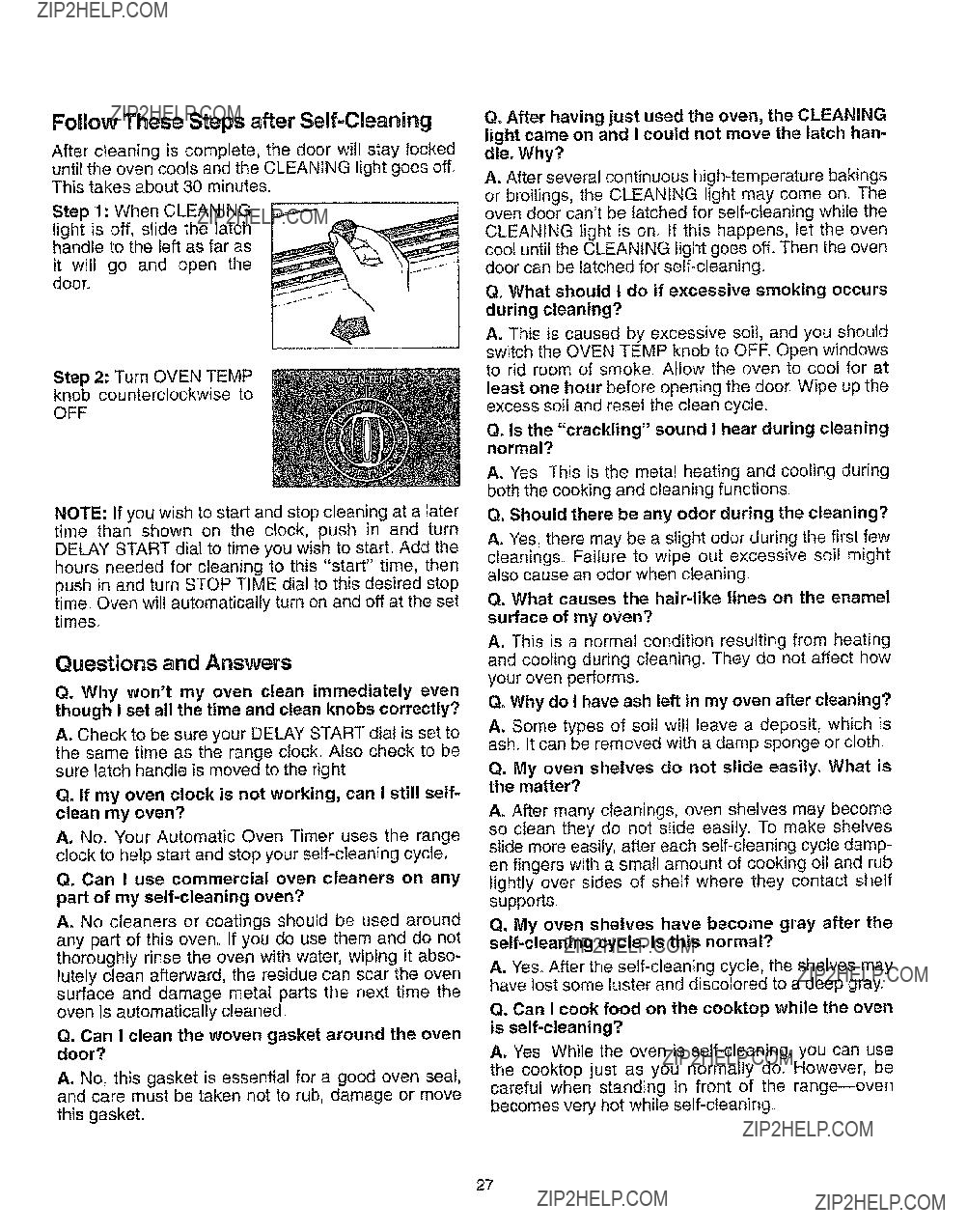
Follow These Steps after
After cleaning is complete, the door will stay locked until the oven cools and the CLEANING light goes oE This takes about 30 minutes.
Step 1: When CLEANING _._- light is off, slide the latch
handle to the left as far as it will go and open the door.1
Step 2: Turn OVEN TEMP knob counterclockwise to
OFR
NOTE: If you wish to start and stop cleaning at a later time than shown on the clock, push in and turn DELAY START dial to time you wish to start?? Add the hours needed for cleaning to this "start" time, then push in and turn STOP TIME dial to this desired stop time. Oven will automatically turn on and off at the set times..
Questions and Answers
Q, Why won't my oven clean immediately even though ! set all the time and clean knobs correctly?
A. Check to be sure your DELAY
Q.If my oven clock is not working, can i still self- clean my oven?
A.No. Your Automatic Oven Timer uses the range clock to help start and stop your
Q.Can I use commercial oven cleaners on any
part of my
A. No cleaners or coatings should be used around any part of this oven. If you do use them and do not thoroughly rinse the oven with water, wiping it abso- lutely clean afterward, the residue can scar the oven surface and damage metal parts the next time the oven is automatically cleaned
Q.Can I clean the woven gasket around the oven door?
A.No, this gasket is essential for a good oven seal, and care must be taken not to rub, damage or move
this gasket??
Q?? After having just used the oven, the CLEANING light came on and I could not move the latch han- dle, Why?
A. After several continuous
or broilings, the CLEANING light may come on The oven door can't be latched for
CLEANING light is on. If this happens, let the oven cool until the CLEANING light goes off. Then the oven door can be latched for
Q.What should I do if excessive smoking occurs during cleaning?
A.This is caused by excessive soil, and you should switch the OVEN TEMP knob to OFR Open windows to rid room of smoke. Allow the oven to cool for at
least one hour before opening the door Wipe up the excess soil and reset the clean cycle,,
A.Yes, This is the metal heating and cooling during both the cooking and cleaning functions
Q.Should there be any odor during the cleaning?
A.Yes, there may be a slight odor during the first few cteaningso Failure to wipe out excessive soil might also cause an odor when cleaning.
Q, What causes the
A. This is a normal condition resulting from heating and cooling during cleaning They do not affect how your oven performs.
Q?? Why do I have ash left in my oven after cleaning?
A.Some types of soil will leave a deposit, which is ash. It can be removed with a damp sponge or cloth,
Q.My oven shelves do not slide easily. What is the matter?
A.After many cIeanings, oven shelves may become so clean they do not slide easily. To make shelves
slide more easily, after each
Q.My oven shelves have become gray after the
A.Yes. After the
Q.Can I cook food on the cooktop while the oven is
A.Yes While the oven is
27
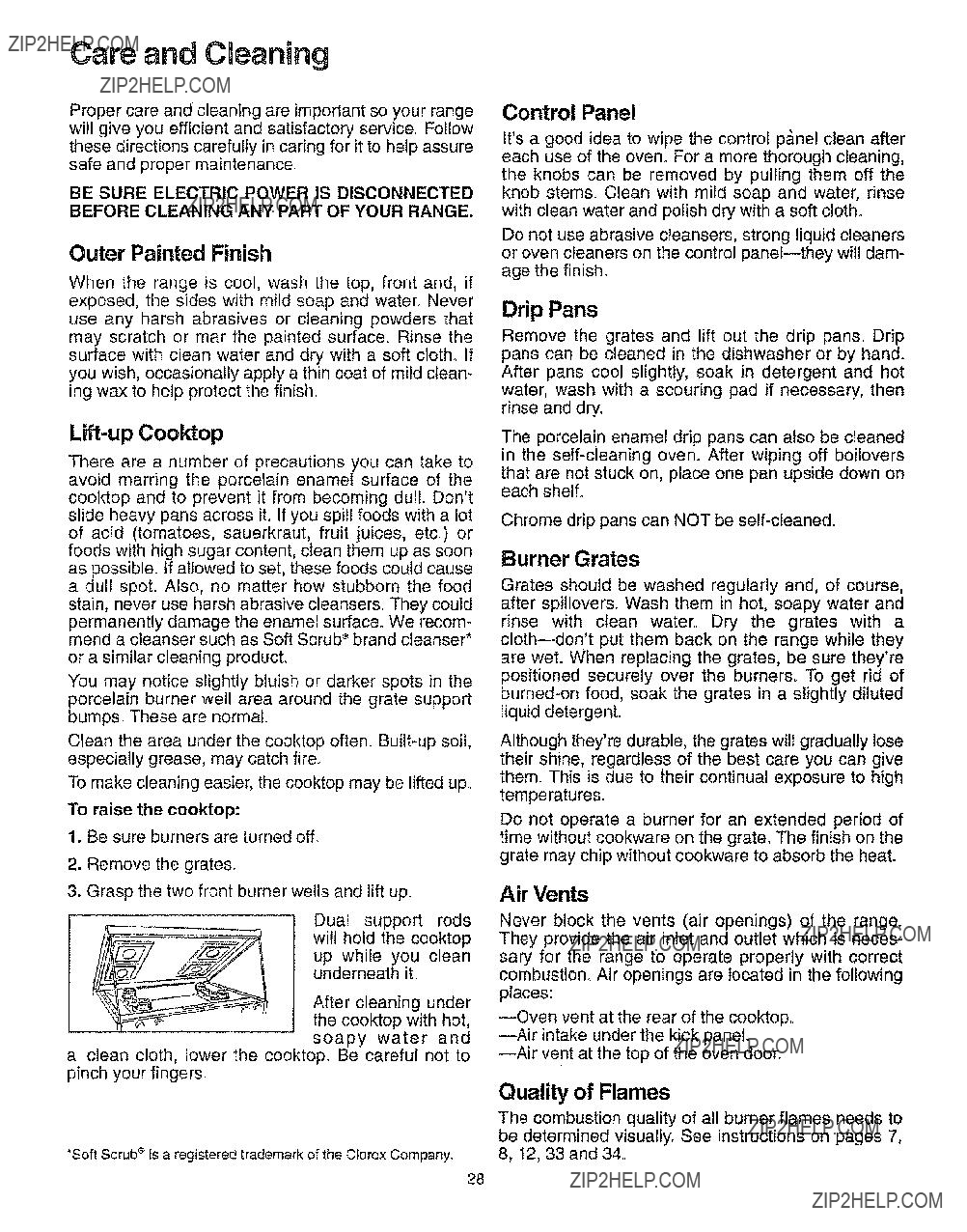
Care and C eaning
Proper care and cleaning are important so your range will give you efficient and satisfactory service. Follow these directions carefully in caring for it to help assure safe and proper maintenance.
BE SURE ELECTRIC POWER IS DISCONNECTED
BEFORE CLEANING ANY PART OF YOUR RANGE.
Outer Painted Finish
When the range is cool, wash the top, front and, if exposed, the sides with mild soap and water. Never use any harsh abrasives or cleaning powders that may scratch or mar the painted surface Rinse the surface with clean water and dry with a soft cloth If you wish, occasionally apply a thin coat of mild clean- ing wax to help protect the finish.
There are a number of precautions you can take to avoid marring the porcelain enamel surface of the cooktop and to prevent it from becoming dull. Don't slide heavy pans across it. If you spill foods with a lot of acid (tomatoes, sauerkraut, fruit juices, etco) or foods with high sugar content, clean them up as soon as possible?? tf allowed to set, these foods could cause a dull spot. Also, no matter how stubborn the food stain, never use harsh abrasive cleansers They could
permanently damage the enamel surface. We recom- mend a cleanser such as Soft Scrub _'brand cleanser*
or a similar cleaning product.
You may notice slightly bluish or darker spots in the porcelain burner wei! area around the grate support bumps?? These are normal.
Clean the area under the cooktop often.
To make cleaning easier, the cooktop may be lifted up
To raise the cooktop:
1.Be sure burners are turned off??
2.Remove the grates.
3, Grasp the two front burner wells and lift up.
Dual support rods will hold the cooktop
up while you clean underneath it.
After cleaning under the cooktop with hot, soapy water and
a clean cloth, lower the cooktopo Be careful not to pinch your fingers.
*Soft Scrub_ is a registered trademark of the Clorox Company,
Control Panel
It'sa good idea to wipe the control p_nel clean after each use of the oven?? For a more thorough cleaning, the knobs can be removed by pulling them off the knob stems. Clean with mild soap and water, rinse with clean water and polish dry with a soft cloth??
Do not use abrasive cleansers, strong liquid cleaners or oven cleaners on the control
Drip Pans
Remove the grates and lift out the drip pans_ Drip pans can be cleaned in the dishwasher or by hand. After pans cool slightly, soak in detergent and hot water, wash with a scouring pad if necessary, then rinse and dry,
The porcelain enamel drip pans can also be cleaned in the
Chrome drip pans can NOT be
Burner Grates
Grates should be washed regularly and, of course, after spillovers. Wash them in hot, soapy water and rinse with clean water Dry the grates with a
Although they're durable, the grates will gradually lose their shine, regardless of the best care you can give them. This is due to their continual exposure to high temperatures??
Do not operate a burner for an extended period of time without cookware on the grate?? The finish on the grate may chip without cookware to absorb the heat.
Air Vents
Never block the vents (air openings) of the range_ They provide the air inlet and outlet which is neces- sary for the range to operate properly with correct combustion?? Air openings are located in the following places:
Quality of Flames
The combustion quality of all burner flames needs to
be determined visually?? See instructions on pages 7, 8, 12, 33 and 34??
28
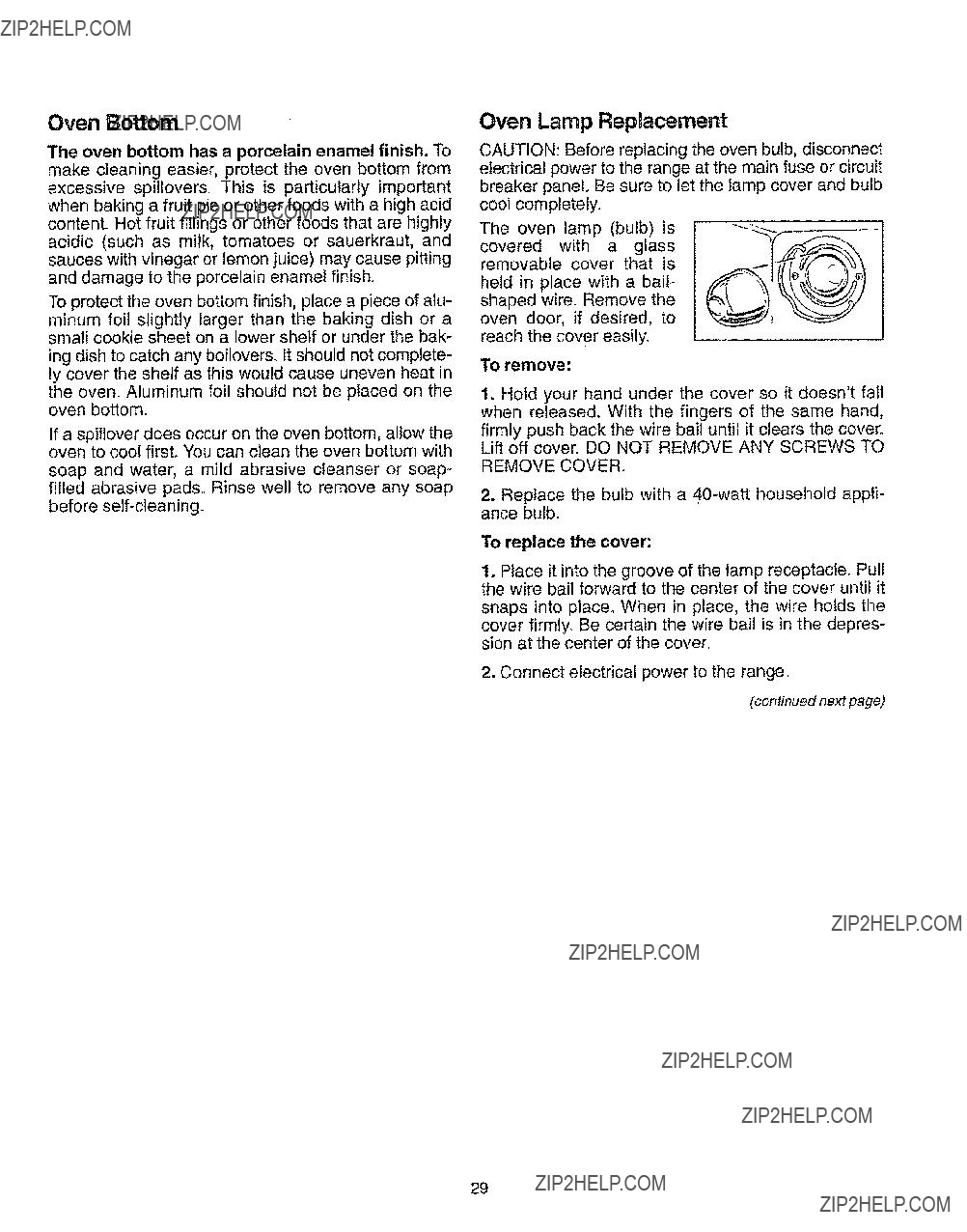
Oven Bottom
The oven bottom has a porcelain enamel finish. To make cleaning easier, protect the oven bottom from excessive spillovers. This is particularly important when baking a fruit pie or other foods with a high acid content. Hot fruit fillings or other foods that are highly acidic (such as milk, tomatoes or sauerkraut, and sauces with vinegar or lemon juice) may cause pitting and damage to the porcelain enamel finish.
To protect the oven bottom finish, place a piece of alu- minum foil slightly larger than the baking dish or a small cookie sheet on a lower shelf or under the bak- ing dish to catch any boilovers. It should not complete- ly cover the shelf as this would cause uneven heat in the oven?? Aluminum foil should not be placed on the oven bottom.
If a spillover does occur on the oven bottom, allow the oven to cool first. You can clean the oven bottom with
soap and water, a mild abrasive cleanser or soap- filled abrasive pads.. Rinse well to remove any soap before
Oven Lamp RepRacement
CAUTION: Before replacing the oven bulb, disconnect electrical power to the range at the main fuse or circuit breaker panel. Be sure to let the lamp cover and bulb cool completely??
The oven lamp (bulb) is covered with a glass removable cover that is
held in place with a baiI_ shaped wire. Remove the oven door, if desired, to reach the cover easily.
To remove:
1. Hold your hand under the cover so it doesn't fall when released. With the fingers of the same hand,
firmly push back the wire bail until it clears the cover. Lift off cover, DO NOT REMOVE ANY SCREWS TO
REMOVE COVER??
2. Replace the bulb with a
To replace the cover:
1, Place it into the groove of the tamp receptacle. Pull the wire bail forward to the center of the cover until it
snaps into place?? When in place, the wire holds the cover firmly. Be certain the wire bail is in the depres- sion at the center of the cover,
2. Connect electrical power to the range??
(continued next page)
29
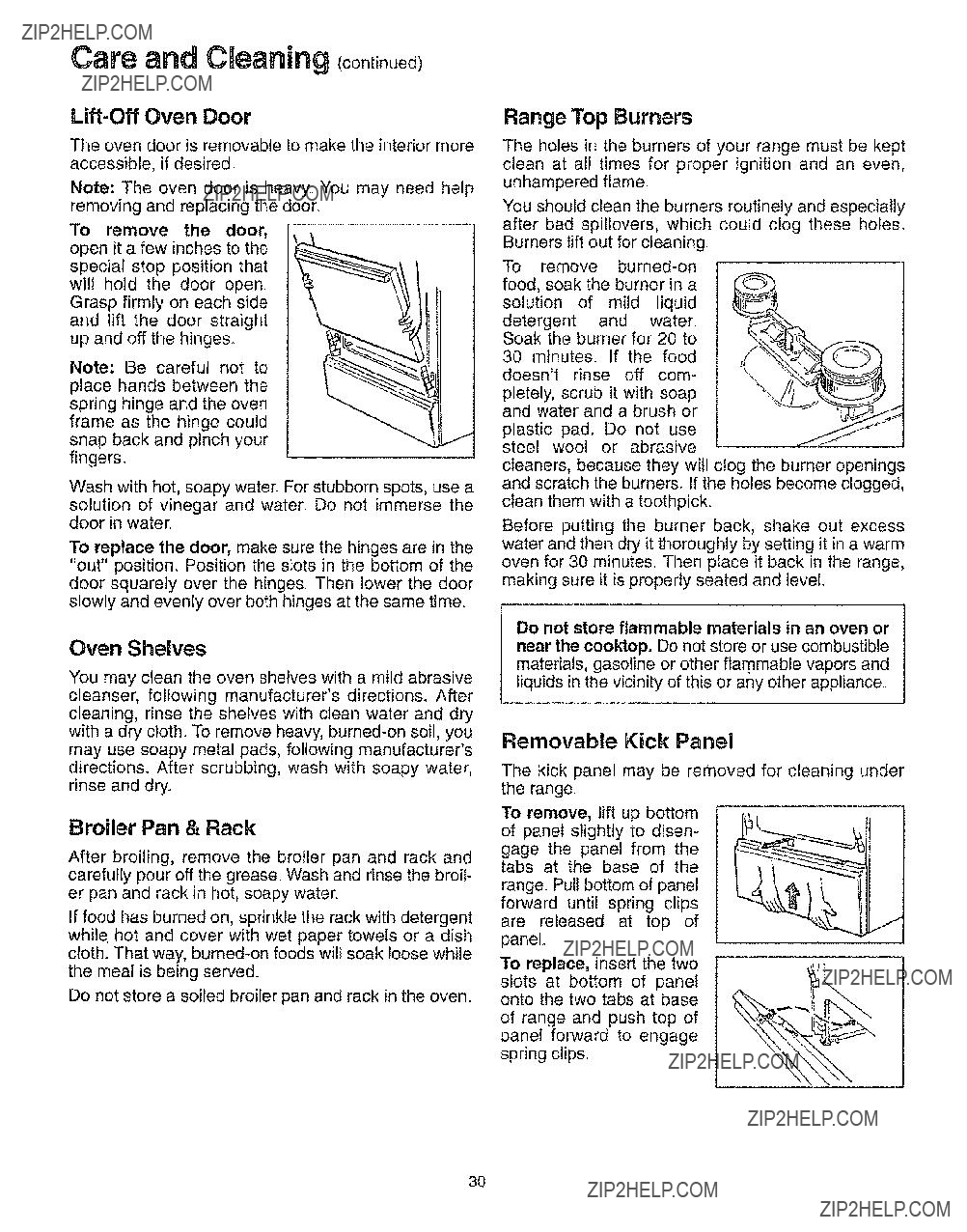
Care and CReaning(continued)
The oven door is removable to make the interior more accessible, if desired.
Note: The oven door is heavy. You may need help removing and replacing the door.
To remove the door, open it a few inches to the special stop position that will hold the door open.. Grasp firmly on each side and lift the door straight up and off the hinge&
Note: Be careful not to place hands between the spring hinge and the oven frame as the hinge could
snap back and pinch yourJ fingers.
Wash with hot, soapy water. For stubborn spots, use a
solution of vinegar and water. Do not immerse the door in water.
To replace the door, make sure the hinges are in the "out" position. Position the slots in the bottom of the door squarely over the hinges. Then lower the door slowly and evenly over both hinges at the same time.
Oven Shelves
You may clean the oven shelves with a mild abrasive cleanser, following manufacturer's directions. After cleaning, rinse the shelves with clean water and dry with a dry cloth. To remove heavy,
Broiler Pan & Rack
After broiling, remove the broiler pan and rack and carefully pour off the grease. Wash and rinse the broil- er pan and rack in hot, soapy water..
If food has burned on, sprinkle the rack with detergent while hot and cover with wet paper towels or a dish cloth. That way,
Do not store a soiled broiler pan and rack in the oven.
Range Top Burners
The holes in the burners of your range must be kept clean at all times for proper ignition and an even, unhampered flame.
You should clean the burners routinely and especially after bad spillovers, which could clog these holes. Burners lift out for cleaning.
To remove
pletely, scrub it with soap and water and a brush or
plastic pad. Do not use steel wool or abrasive
cleaners, because they will clog the burner openings and scratch the burners, If the holes become clogged, clean them with a toothpick.
Before putting the burner back, shake out excess water and then dry it thoroughly by setting it in a warm oven for 30 minutes. Then place it back in the range, making sure it is properly seated and level..
Do not store flammable materials in an oven or
near the cooktop. Do not store or use combustible materials, gasoline or other flammable vapors and liquids in the vicinity of this or any other appliance.
Removable Kick Panel
The kick panel may be removed for cleaning under the range.
To remove, lift up bottom of panel slightly to disen-
gage the panel from the tabs at the base of the
range_ Pull bottom of panel forward until spring clips are released at top of panel..
To replace, insert the two
slots at bottom of panel onto the two tabs at base
of range and push top of panel forward to engage spring clips.
30
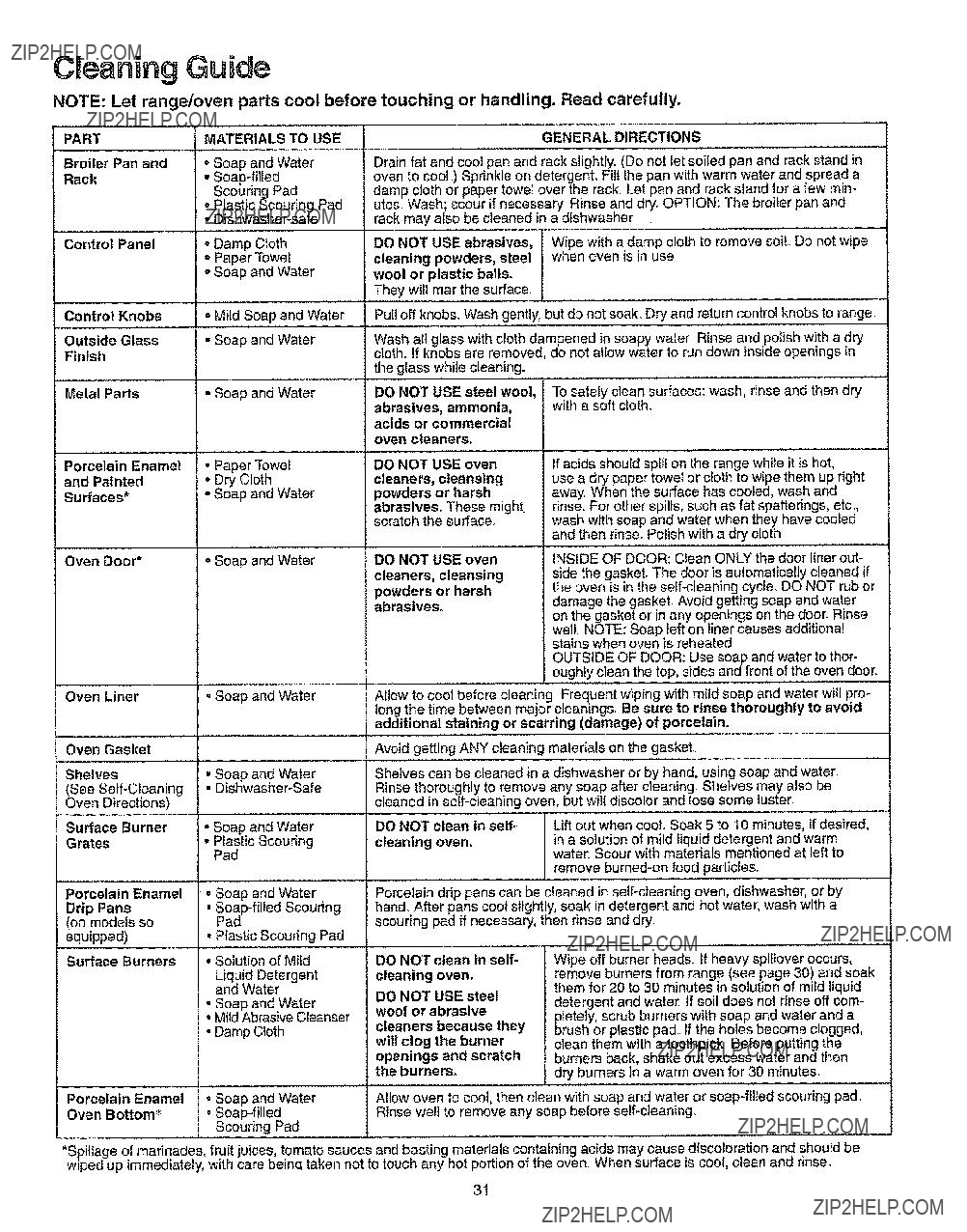
Cleaning Guide
NOTE: Let range/oven parts cool before touching or handling. Read carefully.
GENERAL DIRECTIONS
Drain fat and cool pan and rack slightly. (Do not let soiled pan and rack stand in oven to cool .) Sprinkle on detergent. Fill the pan with warm water and spread a damp cloth or paper towel over the rack. Let pan and rack stand for a few min- utes. Wash; scour if necessary Rinse and dry. OPTION: The broiler pan and rack may also be cleaned in a dishwasher..
Pull off knobs.. Wash gently, but do not soak. Dry and return control knobs to range
Wash all glass with cloth dampened in soapy water. Rinse and polish with a dry cloth. If knobs are removed, do not allow water to run down inside openings in
the glass while cleaning..
DO NOT USE oven cleaners, cleansing
powders or harsh abrasives??
INSIDE OF DOOR: Clean ONLY the door liner out-
side the gasket. The door is automatically cleaned if the oven is in the
damage the gasket Avoid getting soap and water on the gasket or in any openings on the door. Rinse well, NOTE: Soap left on liner causes additional stains when oven is reheated,
OUTSIDE OF DOOR: Use soap and water to thor- oughly clean the top, sides and front of the oven door,
Allow to cool before cleaning. Frequent wiping with mild soap and water wilt pro- long the time between major cleanings. Be sure to rinse thoroughly to avoid additional staining or scarring (damage) of porcelain.
Avoid getting ANY cleaning materials on the gasket.
Shelves can be cleaned in a dishwasher or by hand, using soap and water Rinse thoroughly to remove any soap after cleaning Shelves may also be cleaned in
water. Scour with materials mentioned at left to remove
Porcelain drip pans can be cleaned in
DO NOT clean in self-
cleaning oven.
DO NOT USE steel wool or abrasive
cleaners because they will clog the burner openings and scratch the burners,
Wipe off burner heads, If heavy spillover occurs, remove burners from range (see page 30) and soak them for 20 to 30 minutes in solution of mild liquid detergent and water, tf soil does not rinse off com-
pletely, scrub burners with soap and water and a rush or plastic pad. If the holes become clogged,
clean them with a toothpick, Before putting the burners back, shake out excess water and then dry burners in a warm oven for 30 minutes.
Allow oven to cool, then clean with soap and water or
*Sp age of mar nades fruit juices, tomato sauces and basting materials containing acids may cause disco!oration and should be wiped up immediately, with care beinc! taken not to touch any hot port on ot the oven. When surface is coot, ctean ann r nse..
31

Minor Adjustments You Can Make
Oven Thermostat Adjustment
The thermostat control in your new oven has been carefully adjusted to provide accurate temperatures. However, if your new oven is replacing one you have used for several years, you may notice a difference in the degree of browning or the length of time required when using your favorite recipes?? This is because oven temperature controls have a tendency to "drift" over a period of years..
Before attempting to have the thermostat of your new oven changed, be sure you have carefully followed the baking time and temperature recommended by the recipe.. Then, after you have used the oven a few times and you feel the oven is too hot or too cool,
there is a simple adjustment you can make yourself on the OVEN TEMP knob.
Pull the knob off the shaft and took at the back sider There is a disc in the center of the knob skirt with a
pointer opposite one of the screws.
To make an adjustment, carefully loosen (approxi-
mately one turn), but do not completely remove the two screws that hold the skirt to the knob. Hold the
knob blade in one hand and the outer skirt in the other hand.
To raise the oven temperature, move the screw oppo- site the pointer toward the word HOTTER.. You'll hear a click for each notch you move the knob. To lower the temperature, move the screw opposite the pointer toward the word COOLER. Each click will change the oven temperature approximately 10??E (Range is plus or minus 60 ?? from the arrow.)
We suggest that you make the adjustment one click from the original setting and check oven performance before making any additional adjustments..
After the adjustment is made, press skirt and knob together and retighten screws so they are snug, but be careful not to overtighteno
32
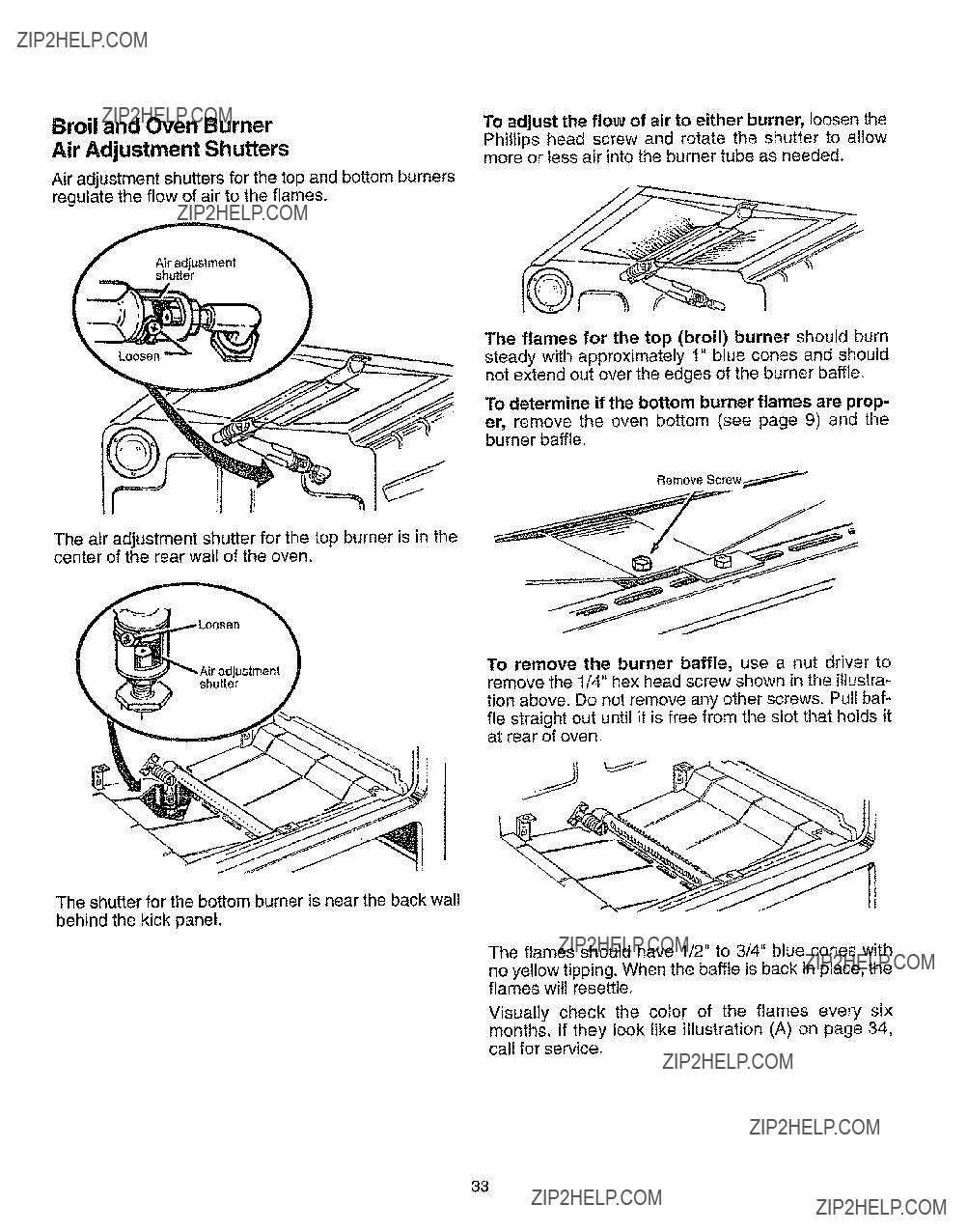
Air adjustment shutters for the top and bottom burners regulate the flow of air to the flames.
The flames for the top (broil) burner should burn steady with approximately 1" blue cones and should not extend out over the edges of the burner baffle,
To determine if the bottom burner flames are prop- er, remove the oven bottom (see page 9) and the burner baffle.
Remove Screw_
f
The air adjustment shutter for the top burner is in the center of the rear wall of the oven.
To remove the burner baffle, use a nut driver to remove the t/4" hex head screw shown in the illustra- tion above. Do not remove any other screws, Pull baf-
fle straight out until it is free from the slot that holds it at rear of oven.
The shutter for the bottom burner is near the back wall
behind the kick panel.
The flames should have 1/2" to 3/4" blue cones with
no yellow tipping. When the baffle is back in place, the flames will resettle.
Visually check the color of the flames every six months, If they look like illustration (A) on page 34, call for service.
33
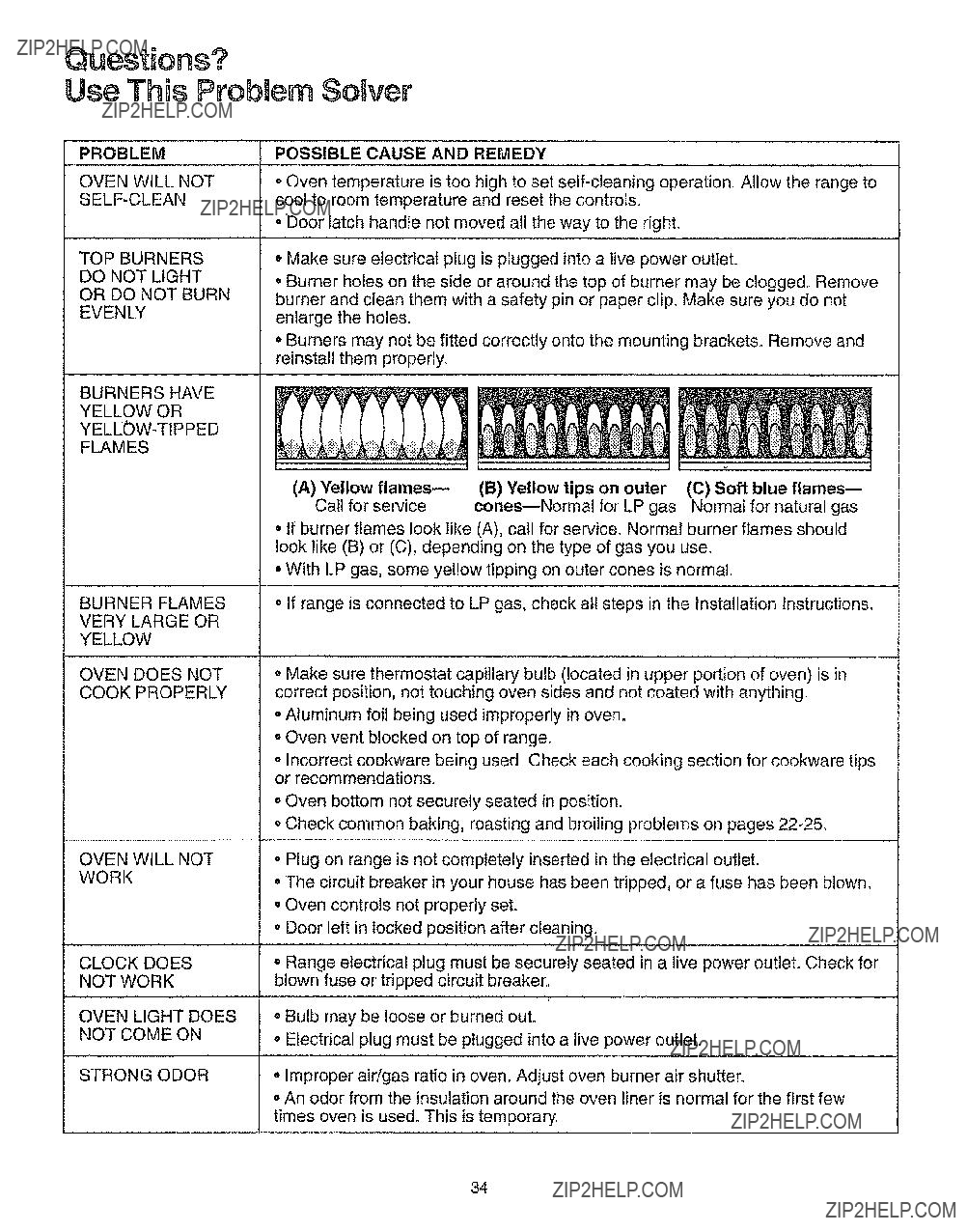
Questions?
Use This ProbUern SoWver
PROBLEM
OVEN WILL NOT
TOP BURNERS
DO NOTLtGHT
OR DO NOT BURN
EVENLY
BURNERS HAVE
YELLOW OR
FLAMES
BURNER FLAMES
VERY LARGE OR
YELLOW
OVEN DOES NOT
COOK PROPERLY
OVEN WILL NOT
WORK
CLOCK DOES
NOT WORK
OVEN LIGHT DOES
NOT COME ON
STRONG ODOR
POSSIBLE CAUSE AND REMEDY
o Oven temperature is too high to set
??? Door latch handle not moved al! the way to the right.
o Make sure electrical plug is plugged into a live power outlet.
o Burner holes on the side or around the top of burner may be clogged., Remove burner and clean them with a safety pin or paper clipo Make sure you do not enlarge the holes.
??? Burners may not be fitted correctly onto the mounting brackets.. Remove and reinstall them properly.
IIi I II!
??? If burner flames look like (A), call for service_ Normal burner flames should look like (B) or (C), depending on the type of gas you use??
= With LP gas, some yellow tipping on outer cones is normal_
?? If range is connected to LP gas, check all steps in the Installation Instructions.
o Make sure thermostat capillary bulb (located in upper portion of oven) is in correct position, not touching oven sides and not coated with anything.
??Aluminum foil being used improperly in oven,.
??Oven vent blocked on top of range.
= Incorrect cookware being used, Check each cooking section for cookware tips or recommendations??
oOven bottom not securely seated in position..
?? Check common baking, roasting and broiling problems on pages
???Plug on range is not completely inserted in the electrical outleL
???The circuit breaker in your house has been tripped, or a fuse has been blown.
???Oven controls not properly seL
???Door left in locked position after cleaning.
?? Range electrical plug must be securely seated in a live power outlet. Check for blown fuse or tripped circuit breaker.
o Bulb may be loose or burned ouL
??? Electrical plug must be plugged into a live power outlet??
?? Improper air/gas ratio in oven. Adjust oven burner air shutter.
= An odor from the insulation around the oven liner is normal for the first few times oven is used?? This is temporary??
34
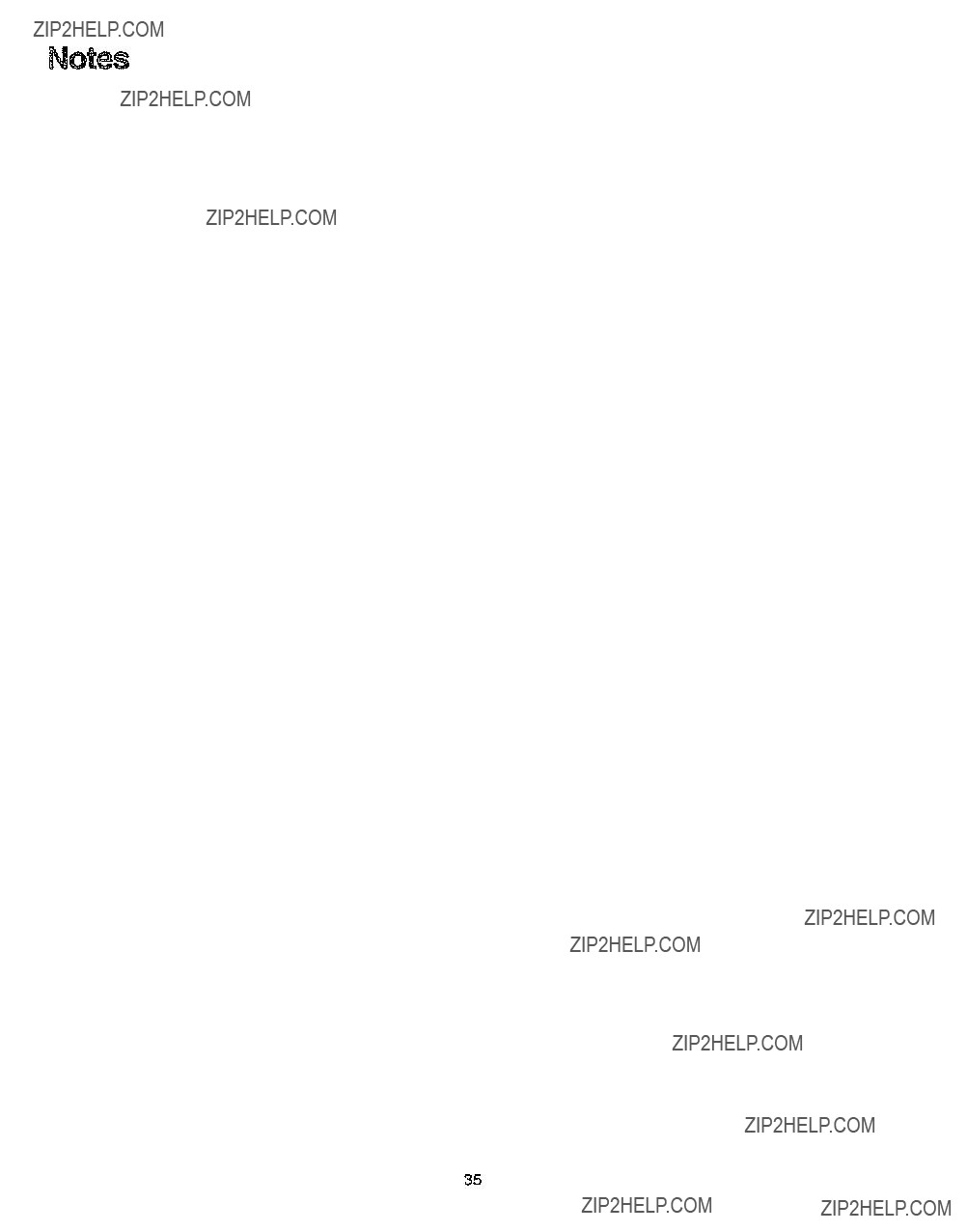
Notes
35
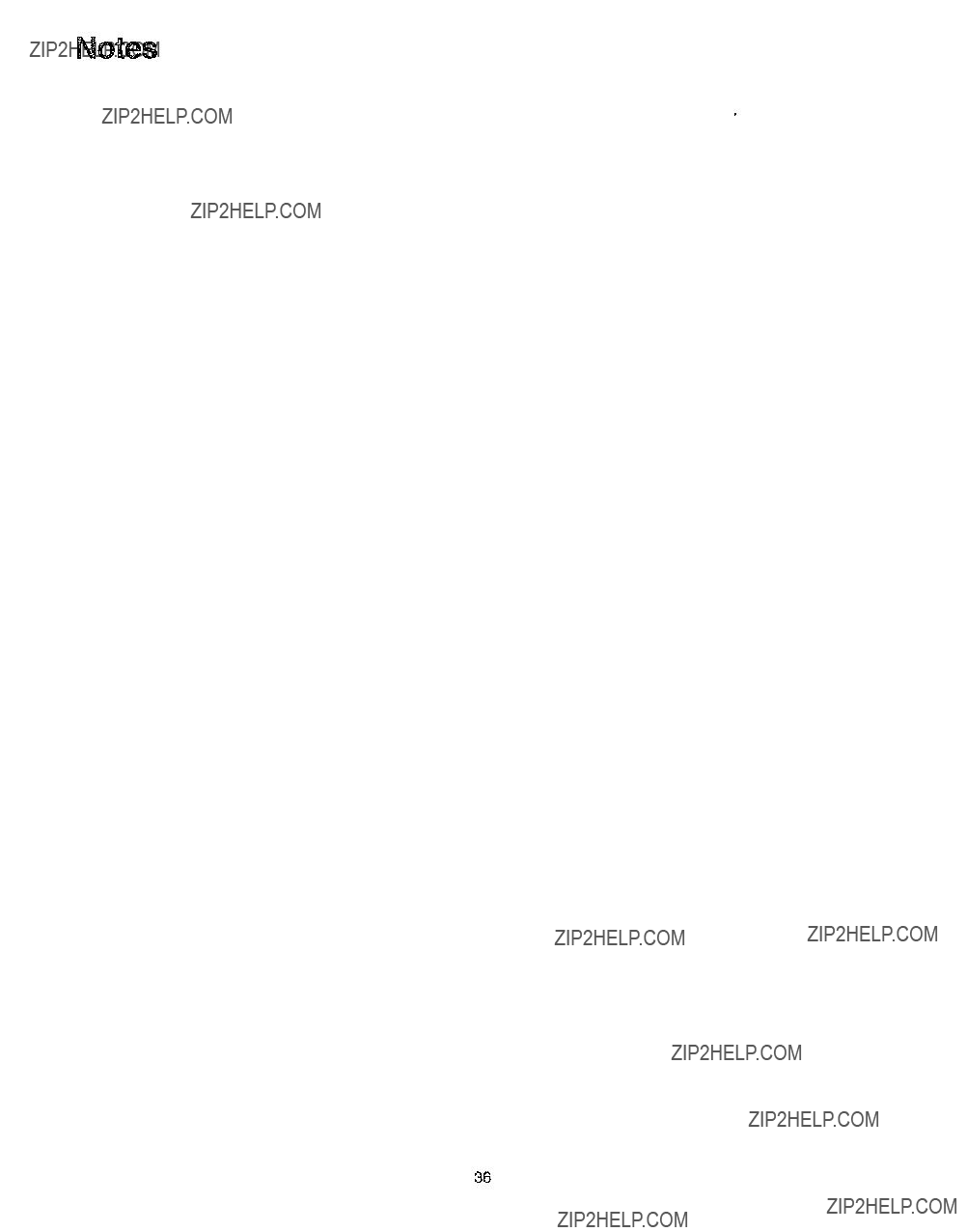
Notes
36

Notes
37
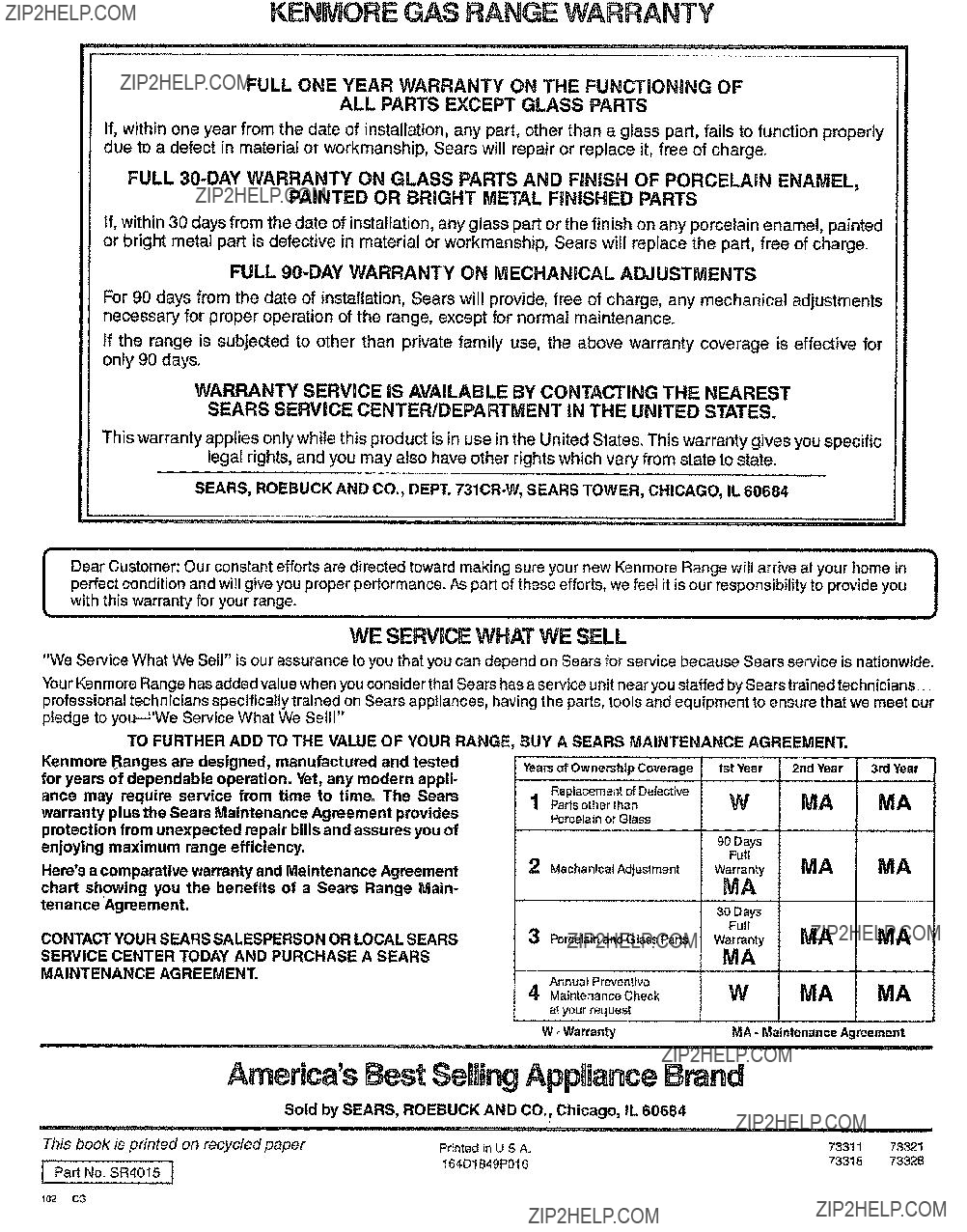
KENMORE GAS RANGE WARRANTY
i ......... =....
FULL ONE YEAR WARRANTY ON THE FUNCTIONING OF
ALL PARTS EXCEPT GLASS PARTS
If, within one year from the date of installation, any part, other than a glass part, fails to function properly due to a defect in material or workmanship, Sears wilt repair or replace it, free of charge.
FULL
PAINTED OR BRIGHT METAL FINISHED PARTS
If, within 30 days from the date of installation, any glass part or the finish on any porcelain enamel, painted or bright metal part is defective in material or workmanship, Sears will replace the part, free of charge.
FULL
For 90 days from the date of installation, Sears will provide, free of charge, any mechanical adjustments necessary for proper operation of the range, except for normal maintenance.
If the range is subjected to other than private family use, the above warranty coverage is effective for only 90 days.
WARRANTY SERVICE IS AVAILABLE BY CONTACTING THE NEAREST
SEARS SERVICE CENTER/DEPARTMENT IN THE UNITED STATES.
This warranty applies only while this product is in use in the United States?? This warranty gives you specific legal rights, and you may also have other rights which vary from state to state,.
WE SERVICE WHAT WE SELL
|
J
"We Service What We Sell" is our assurance to you that you can depend on Sears for service because Sears service is nationwide.
Your Kenmore Range has added value when you consider that Sears has a service unit near you staffed by Sears trained technicians...
professional technicians specifically trained on Sears appliances, having the parts, tools and equipment to ensure that we meet our pledge to
TO FURTHER ADD TO THE VALUE OF YOUR RANGE. BUY A SEARS MAINTENANCE AGREEMENT.
Kenmore I_anges are designed, manufactured and tested for years of dependable operation. Yet, any modern appli- ance may require service from time to time. The Sears
warranty plus the Sears Maintenance Agreement provides protection from unexpected repair bills and assures you of enjoying maximum range efficiency,
Here'sa comparative warranty and Maintenance Agreement chart showing you the benefits of a Sears Range Main- tenance Agreement.
CONTACT YOUR SEARS SALESPERSON OR LOCAL SEARS
SERVICE CENTER TODAY AND PURCHASE A SEARS
MAINTENANCE AGREEMENT.
Replacement of Defective
1 Ps.,otherthan W MA MA
Porcelain or Glass
90 Days
Full
2 Mechanical Adjustment Warranty MA MA
MA
30 Days
Full
3 Pemela|naoGlassPartsWarranty MA MA
MA
Annual Preventive
4 MaintenanceCheckWMA MA
at your request
America'sBest SellingAppliance Brand
Sold by SEARS, ROEBUCK AND CO., Chicago, IL 60684
73311 73321
73318 73328
102 CG